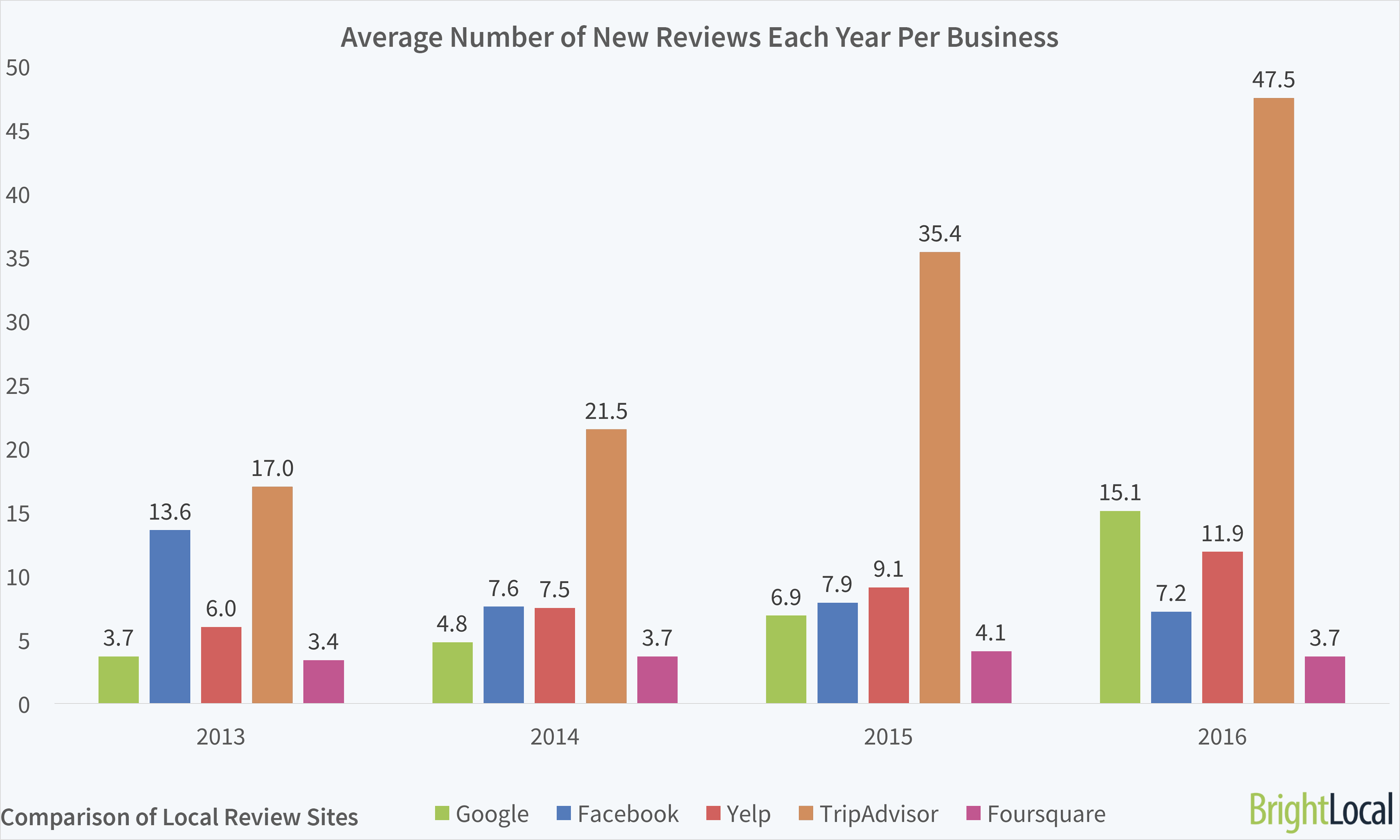Brand Development, Web Design, and Google Analytics Specialists
Experienced in SEM, SEO, Social Media, and Traditional Media
How To Get Geographic Data On Your Customers Through Facebook Pixel And Google Analytics

Google Analytics is a powerful tool that shows all kinds of data relating to your website. Facebook is a powerful social media tool, a platform on which many brands pay for ads. But did you know you can marry the two and find how who your Facebook ads are reaching via your Google Analytics dashboard?
The story behind the stats
It is important to understand the story behind the stats. For example, if you clearly knew your ads were reaching the right people and they were responsible for a constant stream of traffic to your site, you’d be happy to continue paying. But, if they weren’t reaching the right people and not seeing a return on your investment, what needs to change?
Google Analytics is a powerful monitoring tool by which you can see what is working and, just as important what isn’t. Facebook pixel is a means by which you can optimize your ads, and by connecting the two, you have an even more powerful analytical tool with much more information.
Why bother with Facebook ads?
Facebook is a huge, global social media platform. Of the millions of daily users, a large portion is your customers. The business has no physical boundaries in the digital world, and so someone from another county or country can access your website and order online.
You’ll need to make sure organic or natural growth on Facebook is supported. And that means making sure you are consistently posting to your business page. You should be encouraging your followers to like and share, as well as comment and engage with your brand.
As well as paid for adverts, you can also promote posts, another great way of boosting your visibility on this busy social media platform.
You can also tell Facebook what you want to achieve with paid promotions and ads, something that is important as part of your overall online marketing strategy. Even though it is a global platform, there is a growing emphasis on localized ads so that customers who are local to you can find you.
Like all forms of online advertising, the stronger the marketing strategy backing it, the higher the chances of success. But, posting an online ad on Facebook can feel like throwing leaflets into the wind blind. How do you know where they are going to land? Is the right person going to pick them up? When they do pick a leaflet up what do they do with it? How long do they spend looking at it?
With Facebook pixel and Google Analytics, you no longer have to guess because you can track what people do when they see your ad on Facebook and what they do if they visit your website.
What is Facebook pixel?
Facebook pixel is a code you place on your website. It collects data and monitors conversion from your Facebook ads. This allows you to optimize ads and build a targeted audience, great for future ad campaigns. For example, you can remarket to people who have already taken action on your website, such as put things in their basket or liked a product or commented.
It works by placing cookies that trigger to track users when they interact with your Facebook ad and your website.
There used to be different kinds of pixels. Some could track conversions and so on, but now there is one pixel that does it all.
Facebook pixel provides you with important information, all of which can be used by your online marketing team to better target your ads. It means your money spent on ads yields a better return. You don’t have to wait until you start advertising on Facebook to start using the pixel. In fact, the earlier you begin before an ad campaign, the more information you’ll have to create a targeted, successful campaign.
Linking Facebook pixel with Google Analytics
It can look complex, but setting up and dovetailing Facebook pixel with Google Analytics is relatively straightforward…
You’ll need to import data sources into the Google Data Studio
Google Data Studio is a free tool that allows you to import data and create visual reports, giving you a holistic view of your campaigns. As it is a Google product, you won’t need to spend hours connecting the source – Google Analytics – with the reporting platform, Google Data Studio.
Google Analytics up and running!
Google Analytics is used when connected to your website – you do this by inserting a piece of code into the background of your website. This code tracks what people do when they find your website, how long they spend on it, and what pages they looked at. By adding Facebook pixel, you get to see what people do when they find your website through a Facebook advert.
How to generate a Facebook pixel code
This is done in the events manager page. The code generated is unique to your business. Setting Google as the ‘tag manager’, the code is then copied and pasted from Facebook into your Google platform.
Codes can be added for specific actions such as ‘add to cart’ code which allows you to track how many people who found your site through Facebook and added items to their basket and, the most important it, completed their purchase.
Sounds a bit complicated…?
It can be if you are not too sure about coding, how the back-end of your website works, or even how Google Analytics works. It’s also essential to be able to interpret the data and what both the analytics are actually telling you.
It is vital data because it is on this information that your Facebook ad campaign manager can tweak and modify ads so that they yield even better results. Outsourcing management of your online marketing campaigns is another means by which you get the best from your Facebook ads.
Customers change, and so your adverts shouldn’t stay the same. And that’s why understanding analytics is essential and why connecting Facebook pixel with Google Analytics is paramount to success.
Why Is Geographic Segmentation Important In Email Segmentation?

Overlooking email segmentation means you are missing out on sending information that converts your target audience. There are various ways to segment your email list, one of which is based on the geographical location of your users. But why is it important?
The benefits of geographic email segmentation
There are many reasons why segmenting your email list in this way makes for effective marketing.
#1 Different needs and wants relating to location or region
Segmenting your email list based on the location of recipients allows a brand to target the varying wants and needs of customers dependent on where they live. For example, your product may be incredibly useful during long dry, hot spells and if you know a particular area of the country is in the grip of a heatwave, you could target them directly with an email campaign that solves some of their problems and gives the answers they need.
#2 It’s cost-effective
For very little marketing cash, you can grow your business substantially in this way. This is because rather than a general online marketing campaign, you are targeting a campaign to reach specific people. By doing so, you are offering them the products and services that solve a problem that they have.
In other words, a creative email campaign aimed at the right people is more efficient and effective than a blanket approach.
#3 Geographical email segmentation is easy (when you know how!)
You’ve put a lot of time and energy building your database of interested customers. You have asked them for key pieces of information, such as their location, for a reason. Now is the time to use it.
With effective tools in place, you can pull out groups based on different criteria, such as location, to send them emails that are specifically tailored to be of interest to them.
Key to the success of any segmentation of emails is understanding customer behavior. Effectively, you need to identify what the customer’s problem or issue is and how your product or service can solve it.
When does geographic segmentation of emails work?
There are many examples of when this kind of segmentation can work…
Example 1 – Global outdoor wear company
As a global outdoor wear company, sending a blanket email to customers across the globe with money off short-sleeved shirts when half of their customers are shivering in winter makes little sense. A waste of money and effort, this email would only appeal to customers who are in the middle of summer.
By segmenting their email campaign, they can email discounts of summer clothing to those customers enjoying summer and suggest what to look for a padded jacket for those in the grip of winter.
Example 2 – A cycling company
The first example was a broad and obvious one, but what about a cycle company who has a nationwide following? How would geographic segmentation work for them?
There are different kinds of cyclist – there are those who commute by bike to work or an urban cyclist. Then there are those who compete in road races or as part of triathlons. And there are rural cyclists or those that enjoy taking their bike off the beaten track.
Instantly, you can see the different groups and how the environment and their location would affect the type of bike they buy and the type of equipment and clothing they would need. They would also have different problems that need solving.
By identifying the geographic pressure, sending targeted emails to the urban cyclist means a better response than a blanket email to all customers and followers.
Does email segmentation work?
It can seem like a lot more hassle to take the time to segment your database list of email contacts. But here’s the thing – if customers receive emails that are of no interest to them and they continue to receive them, they are more likely to unsubscribe from your list. And so the blanket email approach can do more harm than good.
There are statistics that strongly suggest email segmentation really works. With targeted emails that are of interest to the customer, the email is four times more likely to be opened. Just over a quarter of companies also said that since they started email segmentation, unsubscribe rates dropped dramatically.
24% of companies who regularly segment their email campaigns also found that deliverability improved, sales leads increased and revenue increased as a result.
Research by HubSpot also found targeted, segmented emails that nurtured leads led to an increase in click-through rate – so people clicking on your website from the email – by 8%. In non-segmented emails, this was as low as 3%.
Still not convinced? Research by Jupiter Research found that compared to broadcast emails – the ‘just email everybody on the list’ approach – segmented emails drove 18 times more revenue.
Is geographic email segmentation right for every business?
It can be, and if not, there are other kinds of email segmentation that will work. The message when it comes to email segmentation is clear – a segmented approach means more clicks. And with a great landing page, brilliant website and product descriptions and the like, that can mean more customers and more revenue for your business.
Every customer wants to feel that they are valued by a company, and that starts with sending emails that are useful and interesting, solve their problems and meet their needs, because by doing so, your customer is more likely to engage.
But of course, getting your head around how to do this and what offers to send can be difficult. Which is why email segmentation is an essential part of outsourcing your online marketing efforts. Working with a company who understands the background of successful email marketing is the first important step.
No brand has a bottomless pit of marketing cash, and so it’s no surprise that successful businesses use email segmentation as part of their online marketing efforts. Are you using segmentation? Do you think it might be time you did?
5 Best Email Marketing Solutions For San Diego Small Businesses

Is email marketing a priority for your San Diego business? Do you assume that it will take too much time to set up and furnish with content only to find that the results are few and far between?
With the right email marketing software, your small business could be reaching more customers in San Diego and beyond.
Finding the best email marketing solutions for your business can take time, especially if you are not sure what features you are looking for. We’ve done the legwork for you, identifying five email marketing solutions that are tried and tested. However, we not suggesting that one of these is the perfect fit for your business but we can certainly help you find the right package for your email marketing needs.
#1 Constant Contact
With a fantastic San Diego email marketing package, the likelihood of your emails ending up in someone’s spam folder is reduced thus your efforts are not wasted. With Constant Contact, you would not only be investing in the fastest-growing email marketing service in the world but also one that is considered to be the easiest to use.
In terms of beginner-friendly software, this is certainly one of the best too. As well as easy to manage email lists and contacts, there are also templates to use as long with a marketing calendar to use.
As you would expect, there are tracking and reporting tools too, perfect for keeping an eye on how well your email marketing campaigns are doing. Tapping into your growing social media following is easy too with sharing tools, as well as more complex abilities such as tapping into social media ads and more.
Great for any small business to get to grips with the basics of email marketing, we are more than happy to work with any San Diego business and the Constant Contact platform.
#2 Drip
Different email marketing software provides different solutions and so four out e-commerce clients, as well as bloggers, the Drip platform could be the perfect platform.
As well as making personalization easy, this platform also connects well with both WordPress and WooCommerce sites. Adding sign up forms is easy meaning capturing more leads is effortless.
With Drip, the option to target groups of customers is easier, something that many people feel sets this platform apart from the others. There are marketing automation tools that lead to smarter email marketing, something that every small business needs to convert people to customers via email.
#3 Convertkit
Useful and incredibly powerful is how this platform has been described, something that appeals to many small business users.
Along with a 14-day trial, there are other features to this platform that make it a popular choice. If you know what you are doing when it comes to email marketing, have your strategy, plan and content ready, then this is software is certainly worth a second glance.
Essentially, its power lies in the fact that email sign up incentives can be an offer, bringing you more potential leads and prospects. It also offers the ability to segment email address between those people who are already customers and those who aren’t, essential for personalised email marketing campaigns.
It is also a platform that comes with great support from the ConvertKit team. If you produce a lot of content and have an active, vibrant blog as part of your SEO drive for your San Diego business than this may be the powerful platform that continues to drive traffic and prospects your way.
#4 AWeber
It may be on the oldest email marketing platforms on the block but it is still keeping ahead of its younger rivals. If you are a growing business and feel that you will soon make the step from small to medium-sized business, you’ll need an email marketing system that scales with you.
As well as being the preferred choice of many businesses, it connects seamlessly to WordPress, as well as having a range of email templates, you’ll have access to list management tools, autoresponders and detailed tracking insights with in-built tracking tools.
Support services are great too, from phone support to excellent online articles, AWeber comes with a 30-day free trial and is also one of the best-priced options out there at the moment, perfect for the small business to get to grips with email marketing.
#5 SendinBlue
A European based company, this platform is growing fast and hotly tipped for big things, something that many businesses find attractive, especially if you want to be using the latest tools and trends in your email marketing campaigns.
An extremely easy to use platform, users are impressed by the creative and engaging emails they are able to complete using the platform. Like many other platforms, it uses the ‘drag and drop’ system for adding items in e-newsletters and the like, meaning that it is not just easy to use but hard to get wrong!
However, one aspect of SendinBlue that sets it apart is the use of algorithms to determine when the best times to send your emails.
You can use the free platform, but every email sent will have their branding on or you can start with the paid version from $25 a month.
Is email marketing right for your business?
Not every business owner is convinced by San Diego email marketing, more so in the current climate of tighter privacy controls and concerns over how data is used and shared, possibly without permission of the data holder.
Email marketing does work IF you use data with sensitivity if you personalise emails (tailoring emails to what customers want) and create impressive, engaging content sent at the right time. Sound like too many variables to hit? Not with Above The Fold! Whether you are a B2B or B2C San Diego small business, the team is here to create email marketing campaigns that get results. Maybe the question should be, can you afford not to market via email?
How To Create A Marketing Funnel For Your Business

A marketing funnel is a journey from how people find your business to becoming customers. Creating a marketing funnel is, in essence, about answering a series of questions. Get this right, and a marketing funnel will become one of the most important tools for any small business in San Diego.
Step 1 – Analyse your current marketing funnel
Creating a marketing funnel doesn’t have to be overly complex but it is important to have an understanding of the process. When you identify the current process, you identify gaps. And this is important because where there are gaps, you are losing customers.
Answer the questions how do your customers find you, what do they do next and how do they buy?
Step 2 – Decide what on the end goal of your marketing funnel
Surprisingly, you may think, it is isn’t a natural assumption that the end goal of your San Diego marketing funnel will be ‘making sales’. It could be that you want email addresses for your direct email marketing campaign or book a call to discuss your services and so on.
Without an end goal, your marketing funnel will not taper to an action meaning that potential customers and leads simply swirl around the wide rim of the funnel and then drift away.
Step 3 – Plan your marketing funnel
For many small businesses in San Diego, this is the difficult step because unless you have a finite understanding and knowledge of the funnel process, actually knowing how to put a funnel into practice can be difficult.
You start by looking at a specific starting point, such as your website. You want to ask questions such as how do people find your website? When they arrive on your website, how will you determine what they are looking for and so on?
With an end goal in place, you have something to aim for and thus, you can create a funnel accordingly. For example, if the marketing funnel end goal is to swell your email database contacts, you would create a sign-up pop up for people to join your mailing list.
You might also want to create another pop up for later on in their browsing to remind them to sign up. You may want to offer an incentive and so on.
When it comes to designing and implementing a successful marketing funnel, you want to answer three key questions;
- Does the method of attracting customers accomplish what it was designed to do?
- Is there something putting customers off?
- If someone shows an interest, where does the marketing funnel lead them?
Step 4 – Prioritising the marketing funnel
Marketing funnels only work if they hit the spot and not just once, but time and time again. From converting people into customers to getting more traffic to your website, there are many different goals and paths that a marketing funnel can lead people through.
But for any funnel journey to be a success, there are key components that must be prioritised;
- Is your website up to scratch? – if your website is lacking in content, strong call to actions and has a flow that is stilted and not logical, then you will be losing people before they have even entered the funnel. Prioritise getting the basics right.
- Do you follow up? – so someone hops along to your website and signs up to your e-newsletter… now what? Do you send a welcoming email? In other words, follow up is an important part of the marketing funnel, a chance to showcase your small business brand to a potential customer.
- Adding fuel to the process – just because a customer is in the marketing funnel doesn’t mean that they will automatically buy or follow you. You still need to add fuel to the marketing ‘fire’ and that means making sure that people don’t forget who you are. This doesn’t mean bombarding people but linking and using other marketing processes such as social media ads, pay per click advertising and so on.
Step 5 – Tracking results
Keeping track of the numbers can hound your every moment or provide you with information that is either valuable or nonsensical. We can become hung up on numbers, becoming obsessed with watching the hit counter or the like button counter increasing.
On one hand, you need to treat the numbers with caution but on the other, you need to understand the information they are giving you. A marketing funnel should come with its own data.
It should tell you how many people are filtering through each stage of the funnel. What they may not tell you is why customers are stalling at a certain stage and not making through to the final end goal, whatever you have set hat to be.
It is highlighting there is a problem and one that needs to be fixed. It could be a simple case of what the customer needs to do next is not clear or the call to action is not strong enough.
From monitoring increased hits on the website to understanding bounce rate, to watching your email database grow to making more sales – your end goal will determine which statistic means the most – understanding the broader picture of marketing metrics will see you avoid costly mistakes.
Step 6 – Book Above The Fold for a FREE consultation
Frankly, marketing offline and online in an increasingly competitive marketing place is daunting. For a San Diego business like yours, you know that not marketing your San Diego business is not an option but you also have one eye on the marketing budget. You need to spend your marketing budget in the right place at the right time and aim ads and the like at the right people.
There are a lot of variables to get right which is we offer a free consultation. We look at your current marketing strategy and plans, how well your marketing funnel is functioning and give you an idea of how we can make more from all your marketing efforts, as well as introduce a few new ones. Now nothing is holding you back – give the team a call today (or send us an email!).
5 Digital Marketing Trends To Look Out For In 2019

Digital marketing encompasses the many different channels your business could utilise to meet the needs of customers. Contrary to what you may think, San Diego digital marketing is not just about selling but about engagement and interaction too.
Why both with digital marketing?
As a small business, there are many pressures on your time, resources and budget. The world of digital marketing can seem vast, overwhelming and complex. With the right support from an expert digital marketing agency in San Diego, however, you can grow the marketing avenues you use and grow results too.
From maximizing SEO to pay-per-click adverts to email marketing, digital marketing opens up a whole new landscape for all business, but especially for the start-up and the smaller business too.
But what trends are coming our way in terms of digital marketing in 2019? How can a small business utilize them? And how do trends relate to a business whose customers are located in the same town, city or county?
#1 Artificial intelligence
Does this phrase make your hair stand on end or do you understand that come 2019, this will be a tool you can use for your small business with great effect?
Artificial intelligence is almost like an automated answering system but via your website. You’ll have seen this on websites – it is the live chat facility that pops up, asking if you have any questions or ‘how can we help you today?’.
Relatively inexpensive and easy to manage, customers realize that these live chat facilities are a way of breathing life into the FAQ section, almost. Customers tend to ask the same type of questions when looking to buy products or services, so why not automate this with artificial intelligence?
Available 24/7, you’ll lose fewer customers as they will feel a greater sense of interaction. It also shows a level of professionalism too, something customers look for in ALL brands and businesses, large or small.
#2 Your website MUST be mobile-ready
We’ve been using smartphones for years and so it seems inconceivable that there are still websites out there that are not readable, accessible or usable when accessing them via a smartphone or tablet.
If you haven’t already done so, you must make your San Diego website mobile ready for 2019 and beyond. The simple truth is, smartphones are here to stay and with more than half of all organic searches coming from mobile devices, it pays to have a website that is agile and responsive in any format.
#3 Video will become increasingly important
Take a look at the success of IGTV – the video format on Instagram – and you will see just how important video has become. But in 2019, as a digital marketing tool, it is expected to become even more popular and important.
However, like most things, there were a set of rules developed when it came to ‘going live’ or creating videos to attract attention and custom. For example, the shorter the better was a golden rule for video, as was don’t put a call to action in as this puts people off.
However, it seems that the rulebook is being ripped up, something we think rules should be all about! Videos can be everything from instructional to a marketing tool or just a bit of fun.
Movement on a website and on social media is important – it attracts attention and we like nothing better than being able to see or visualize a business. It breeds familiarity with a buyer, something that can prove lucrative to a business.
You can also utilize the power of video to make the most of your brand’s geographical location. Digital marketing is not just about selling on the web but about selling locally too, picking up a local following and so on.
There is nothing to say that as part of your marketing, you can’t showcase your locality and the beauty of it…
#4 Influencer marketing will be bigger
In every industry, there are people who are considered experts. On social media and other sites, there are people who are considered experts in your field. Collaborating with them can be beneficial to you both.
It is not just about advertising, but about gaining traction in your industry. With the right people at the right price point, you could introduce your product, services and brand to a whole new audience.
Or by hooking up with a social media influencer, you could affirm to customers that your brand is the place to go.
Effectively, influencer marketing is the digital equivalent of ‘word of mouth’. Millennials, for example, are seven times more likely to buy from a brand if their products are recommended or highlighted by an influencer.
This comes at a cost and so don’t try to be clever and ask for free marketing in exchange for a few products. This is likely to backfire. Influencer marketing in San Diego or indeed anywhere needs to be managed so that it is beneficial to both and not just one-sided.
#5 Data collection will become a bigger issue…
… even though it is already becoming a hot potato that no one wants to take a firm hold of. In Europe, the GDPR rules are making their presence felt and for any business that does business with EU based customers, GDPR needs to be followed – or businesses can face a hefty fine.
But the data brands collect from customers or people who come across their website is a big issue, no matter where you live. Who gains access to it and why is a growing concern too.
Digital marketing brings huge rewards but it needs to be done ethically, with the minimum amount of data collected by your on customers, clients and followers, if you need to collect data at all.
Why stay on top of digital marketing trends in 2019
If you don’t, you risk falling behind your competition. And when you fall behind, it takes twice the effort, time and resources to catch up and then more again to get back in front.
What you need is a customized digital marketing strategy, producing bespoke solutions for your San Diego business. Above the Fold Agency can help with all aspects of San Diego digital marketing for 2019, from creating a strategy to planning the best way to get results for your small business.
Contact us today to receive a free digital marketing consultation for your business.
7 Simple Strategies To Get The Most From Yelp

Independent review sites are a great move for any business, providing that is, you manage your presence online and garner a following that helps your business to be pushed up the rankings.
Yelp, along with other search-service websites, has revolutionized the way customers search and interact with businesses. From restaurants to cafes, to car mechanics and artisan food producers, Yelp can be a fantastic marketing tool for businesses in San Diego, and indeed, anywhere else in the world.
With 130 million unique visits a month, it pays to understand how harnessing the power of Yelp will help your business.
#1 Quality speaks
Quality service is something that we all look for in a business and when this exceeds what we were expecting as customers, we are usually more than happy to tell others.
Of course, just as people love what you do, there will be some customers who don’t love what you do.
This customer review culture may appear scary, but it can be the catalyst for reviewing and improving the services and products that you have on offer. We also have to remember that customers are intelligent creatures and they can see through ‘one person having a gripe’ as opposed to the whole business being bad.
Having said that, if the complaints are about the same thing, maybe there is something that you need to change.
#2 Create a fantastic Yelp profile
How many business profiles have you created for apps and third-party websites? And here we are, asking for another one on Yelp.
However, if you are serious about harnessing the power of Yelp for San Diego business visibility – remember those 130 million unique searches a month! – then creating an interesting business profile on the website is fairly critical.
This says a lot to potential customers too. The platform gives you plenty of tools and suggestions on how to create a business profile that shines the best spotlight on what you do.
#3 Encourage your customers to use Yelp
Just like we see suggestions in store to like what a business does on other platforms, like Facebook, you should be encouraging people to leave a review on Yelp.
There are occasional scandals with brands paying customers or writers to leave reviews so that it pushes up their review score. While this is dancing on the edge of moral and legal responsibility, there is nothing wrong with encouraging reviews from genuine customers.
#4 Getting the balance
We mentioned earlier that not everyone will love what you do. Giving a business in San Diego a good bashing is all in a day’s work for some customers, therefore, it is no surprise that many businesses have concerns about ratings and reviews on third-party review sites and other platforms.
Here’s the kicker – the more positive reviews you have, the less of an impact an occasional bad review will make. Let’s be honest – stuff happens – and sometimes, people don’t get the best.
The important thing is understanding how to handle this at the time but also how to handle a poor review online. But like we said, if you have plenty of genuine, good reviews, your rating won’t plummet to the bottom of the cliff if someone leaves a poor review of your business.
#5 Don’t be tempted to buy reviews
The temptation is strong but you must resist simply because Yelp has an algorithm that detects fake reviews for San Diego businesses. In fact, one in five reviews is detected as fake, although this algorithm is not perfect. Genuine reviews have been filtered out of the search.
Yelp is also looking at other ways of detecting fake reviewers and although you may want to build your reputation on Yelp, fake or bought reviews is NOT a worthwhile strategy.
#6 Engage and connect with customers
The thing with reviews is that many, many customers take the time to leave a review expecting nothing to happen.
However, we all see the outcome when someone leaves a bad review and the business responds with kind or hilarious reply. But what about when customers leave a complimentary review? What happens?
Yelp and other similar platforms are built on interaction and that means that every San Diego business needs to interact with their customers on the platform. Effectively, you can encourage people to use yelp in San Diego and your business can use it as an open forum for discussion.
As well as reviews so other customers can assess whether they want to buy from you or not, Yelp is a great listening tool as well. What is it that customers are asking for or expecting? Can you change your business to answer their need? Do your products or services need updating?
#7 Use the platform to its full advantage
Yelp offers businesses a range of features that once you understand how they work, you can use to your full advantage.
For example, Yelp Deals is a prepaid voucher system that gives customers discounts off your products and services. For example, a customer may buy a voucher for $10 but the customer redeems it for $20.
Yelp Reservations is another tool that can help restaurants and cafes, ideal for easy reservation services for customers.
More Information On Getting Yelp Reviews For Your Business
Word of mouth is an effective marketing tool and always has been, hard to believe in the digital age. However, platforms like Yelp are transforming this word of mouth into something that can be harnessed online.
Review sites can be both a blessing and a curse. On one hand, you can use your happy customers to spread the word about who you are and what you do. But on the other, a poor review or a series of bad reviews can create difficult conditions in which to trade.
That said, a business with a forward-thinking attitude will look at these reviews objectively, using them as a platform from which to grow their business.
Getting it right also means engaging and connecting with customers. From responding to a poor review to entering into discussion with fans and followers, Yelp is just one platform you can use to push your business forward in the online world.
Speak With Above The Fold Agency Today
If you are looking for a digital marketing agency in San Diego to help you increase your online presence, the team at Above The Fold Agency is here to help. Contact us today to receive a free consultation.
Email Marketing Segmentation Strategies that Grow Your Business
Email marketing segmentation is a huge boon for businesses. Marketers know segmenting emails into various groupings not only improves open rates, but also click-through rates that ultimately lead to conversions.
Recent data provided by Mailchimp reveals that segmented campaigns receive 14.31% more opens and 100.95% more clicks.
Now more than ever, segmentation is proving to be a greatly effective strategy for businesses looking to drive customer engagement and sales.
It’s All About the Group
Email segmentation is all about the group, and the art of positioning subscribers into groups based upon different factors like: behavior, interests, age, gender, location, and so on. Depending on your industry and goals, the factors will adjust accordingly.

According to DMA, marketers have found 760% increase in email revenue from segmented campaigns. This begs the question, if all your subscribers are different, why are you treating them like they’re all the same?
Established groups should be diverted into buckets fitting the factors you’ve outlined that then serve them specific and curated content and offers they’re most likely to take an action on.
What’s even cooler about segmentation is you can tap into your subscriber’s aspirational self, and not just target based upon where they are in their customer lifecycle. A tactic expertly used by luxury brands.
Segmentation Strategies:
Before dividing up your contact list it’s important to understand a few different proven segmentation strategies. In fact, these are strategies you can immediately adopt today so you can start seeing results tomorrow.
1. Demographics
Demographic data is your launching pad for segmenting your email subscribers into specific lists. Demographic data includes factors like age, gender, income level, company position, education, etc. Seemingly simple demographic data can tell you a great amount about your customer’s wants and needs, and therefore how you can serve them and even turn them into raving fans.
Our recommendation is to acquire as much demographic data from your customer upfront, without scaring them off of course. Whether they’re filling out a form to sign up for your newsletter or are in the purchase process, this is your opportunity to start them off correctly in your email funnel.
For example, if you’re an outdoor retailer, gender is probably at the top of your list so you know which products to suggest to your customers. If you’re a marketing consultant, then knowing your customer’s job title is valuable.
What metrics are the most integral for you business? Be sure to include these in your customer’s signup process.
2. Email Engagement
What better way to sort your customers than by the way they interact with the messages you’re already sending? Segmenting based on email engagement is a simple and effective method that will have a major impact on your results.
Thankfully email marketing services already do a bit of the leg work for us by providing open and clickthrough rates on each email you send. With these metrics you discover your active vs. inactive users.
An inactive user would be someone who hasn’t open an email in three months or more. This is a customer you want to bring back into the fold. Tailor a campaign to re-engage them, whether through a discount offer or a “hey we haven’t seen each other in awhile, check out what’s brand spanking new” type message.
Conversely, you can reach out to your customers that are highly engaged and repeat buyers. We’d call these people your fans. Announce to your fans about an upcoming sale that they’re receiving exclusive first-access to since they’re a loyal customer. If they clickthrough then mark them as “interested” or whatever label you deem appropriate. Then you can develop a specialized campaign to further target them as consistent (maybe even reliable) buyers.
3. Geographic Area
For businesses where geographic location makes a big impact on purchasing decisions then segmenting based on geographic location data is paramount.
A great example of a brand doing this right is Spirit Airlines. Every customer that uses Spirit must filled out basic information like sex, age, and address. The address category is what allows Spirit to target its customers based upon location.
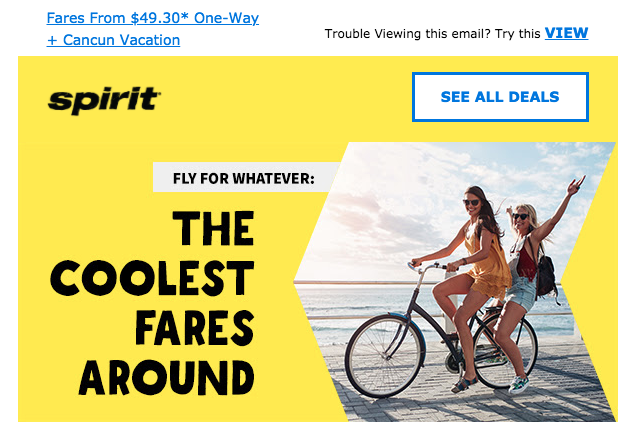
If you’re living in San Diego, why would you care about flight deals out of Denver? You wouldn’t. And this is why geographic location data segmentation is powerful.
Spirit is able to target and supply customers with information, deals, and fun trip facts based upon where you live and where you’re headed. Thus driving open rates and engagement.
Here are a few more examples of ways to use geographic data:
- Location-specific content: Offer a personalized experience by including a specific location in your headline and/or content
- Advertise regional promotions: Offering a Pacific Northwest specific sale? Send focused emails for this promotion to customers in the region.
- Time-based: Send out email at optimum times for customers in different time zones
4. Personal Interest
This is where it gets a little trickier, however if you can pull it off it will greatly help with granular segmentation strategies. You can gain information on your customer’s personal interests by creating user profiles on your website or by using an email subscription center where they can tick off their purchasing or information interests.
You can invite them to do this either in the signup process or encourage them down the road in follow up emails to complete their profile online. Having this information is an amazing tool to help you target customers effectively, and avoid wasting their time with let’s say tech products when their only interest is in beauty products.
In conclusion, email marketing is a highly effective tool that when used correctly can not only nurture your current customer base, but also grow it to unprecedented levels. All you need is a simple email marketing service, knowledge of your customers, creativity, and the drive to build out these segmentation strategies.
Here are a few email marketing services we recommend:
Contact us to learn how we can help your business with email marketing strategies!
Comparison of Local Review Sites: Which Platform is Growing the Fastest?

* Original article *
- Google is the review platform that consistently gains the highest number of new reviews, followed by Facebook, then Yelp
- The average business got fewer new reviews on Facebook in 2016 than before – suggesting a lack of engaged reviewers
- TripAdvisor achieves the most new reviews per business on the platform
- Which ‘local’ review site has seen the greatest and fastest growth in new reviews over the past five years
- How each of these leading ‘local’ review sites has grown year on year, and month by month
- Whether any review sites are experiencing a slowdown of growth
Methodology
We analyzed the review data of approximately 50,000 US-based businesses using data gathered in our ReviewFlow reports. The data set comprises a broad sample of local businesses from many different categories; the data has been aggregated and anonymized.
The data stretches back as far back as online reviews do, but we chose to focus on the past five years (2012-2017) for annual comparisons, and the period July 2016 to July 2017 for a more in-depth look.
We focused the study on five of the most prominent local review sites – Google, Facebook, Yelp, Foursquare, and TripAdvisor. Four of the review sites carry listings and reviews for business in all industries. The fifth, TripAdvisor, was selected due its popularity and prominence in the online review world, and to provide a contrast to the generic review sites.
We chose to include Foursquare because it was once the darling of local-social engagement, and accumulated a lot of reviews and ratings data on local businesses. In recent years Foursquare has pivoted to focus on providing Location Intelligence to help businesses reach local consumers, but they still operate two local-social apps which engage local consumers.
We didn’t look at product or general review sites (e.g. Amazon, Trustpilot) as we are focused on understanding the impact of reviews on ‘local’ businesses (SMBs & Enterprise).
Cumulative Growth in Reviews (2012-2017)
This chart explores the cumulative growth of reviews on the five review sites we analyzed.
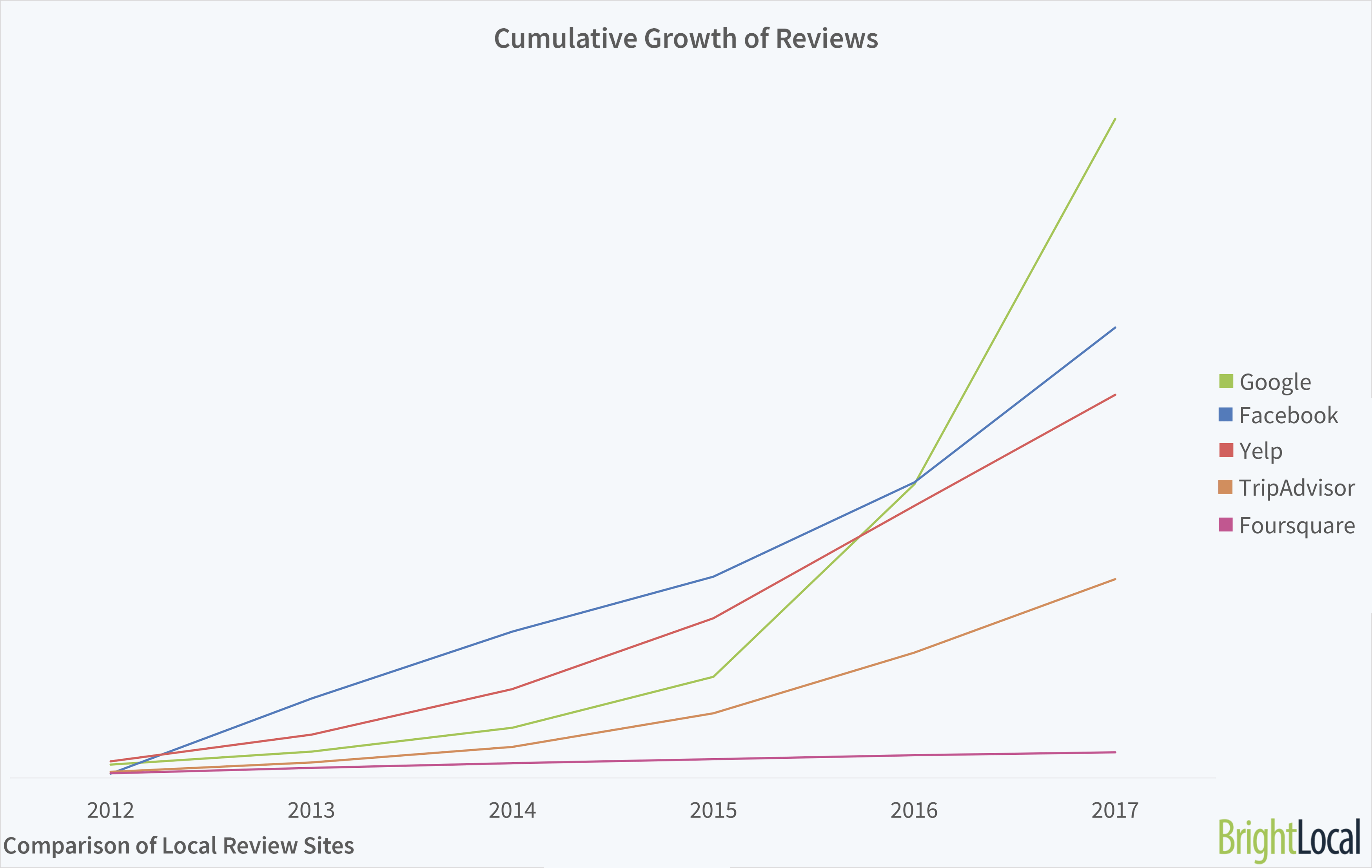
Fastest growing review sites:
- Yelp
- TripAdvisor
- FourSquare
Since 2015, Google has seen the most dramatic increase in the quantity of reviews compared to the other review platforms. Yelp, Facebook and Tripadvisor have all seen an acceleration in their accumulation of reviews – so this is a positive story for all of them – but Google is growing the fastest by far.
Google’s sheer scale coupled with its native integration into Android devices gives them both the biggest audience and the best route to market to prompt users to leave reviews for recently visited businesses. See below for more on this.Foursquare is the only review platform that has plateaued over this period, which isn’t surprising given the company’s change in focus.
Review Growth Compared To Previous Year
This chart shows the percentage growth in the number of new reviews for each site vs the previous year. From this chart we can determine the rate of growth and which site is accumulating reviews the fastest.
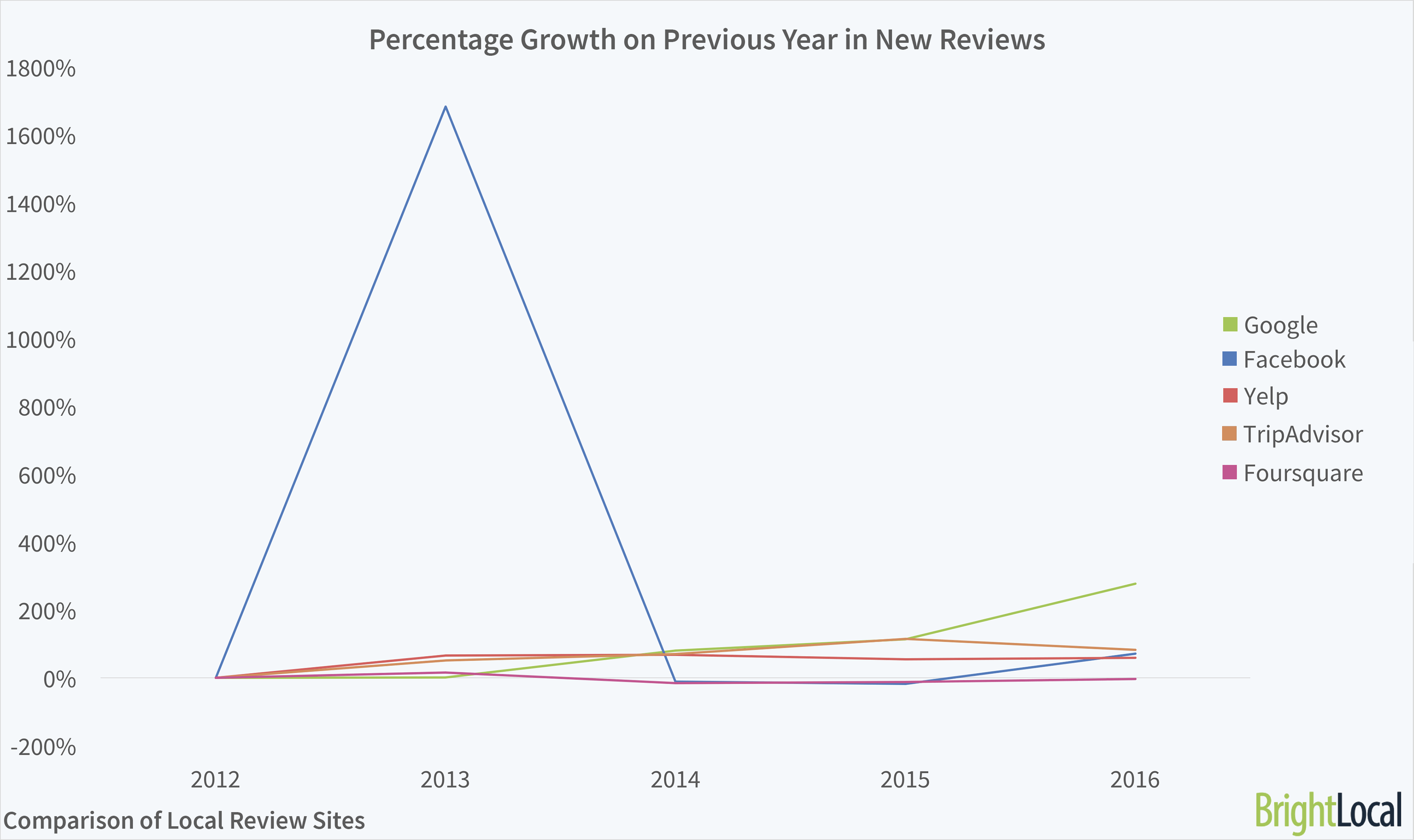
The big story here is the massive jump in new reviews that Facebook saw in 2012-13. This was around the time they first enabled reviews on their service and focused on encouraging users to write reviews, so they saw significant growth from a very low base.
From 2013-2015, Facebook grew slowly, until a big uptick in reviews in 2016.
Review Growth Compared To Previous Year (adapted)
This chart is the same as the one above, but we have ‘flattened’ the spike in Facebook reviews in 2012-2013 to enable us to see the growth in the other review sites.
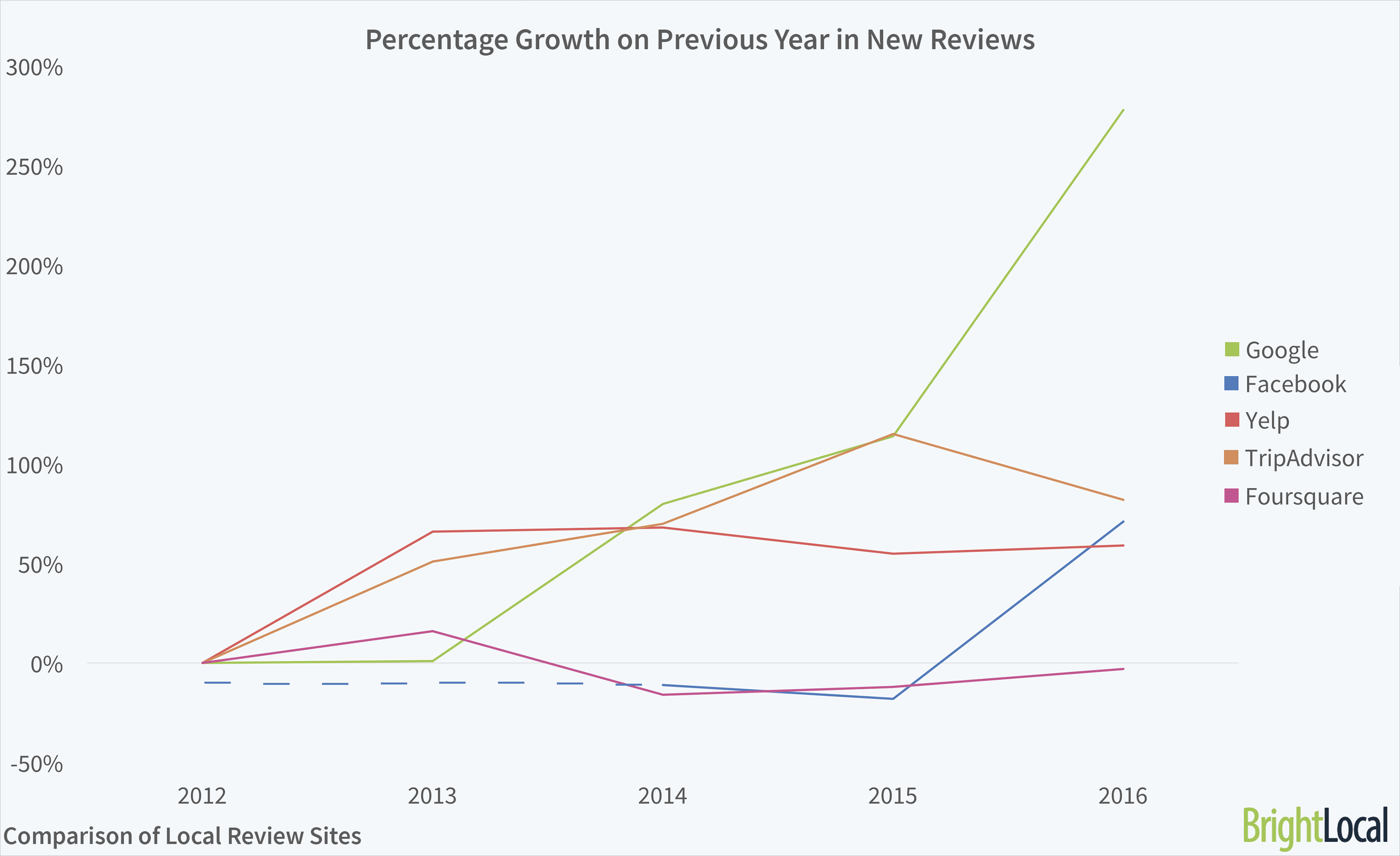
Key Findings:
- Google is acquiring reviews at the fastest rate – new reviews jumped 278% in 2016 from 2015
- TripAdvisor is the second fastest-growing review site – up 82% in 2016 (but slowing from 115% growth in 2015)
- Facebook’s accumulation of reviews was slow in 2014 and 2015, but then it significantly jumped in 2016
- Yelp’s review growth has slowed since 2014 – but is still growing
- Foursquare is the only review site to consistently receive fewer reviews than in the previous year
| Review site | 2013 | 2014 | 2015 | 2016 |
| Yelp | 66% | 68% | 55% | 59% |
| 1683% | -11% | -18% | 71% | |
| Foursquare | 16% | -16% | -12% | -3% |
| 1% | 80% | 114% | 278% | |
| TripAdvisor | 51% | 70% | 115% | 82% |
Average Number of New Reviews Per Business
This chart shows the average number of new reviews gained in each year for a business using the platforms.
When looking at the average number of reviews a typical business has on each platform, TripAdvisor is the clear frontrunner. In 2016, each business in our sample gained an average of 47.5 new reviews – triple the amount the average business on Google received. Read more on TripAdvisor below.
While TripAdvisor may get fewer total reviews than Facebook, Google, and Yelp overall, it receives a far higher concentration of reviews per business across its specialism. Want to find out more about niche review sites for any industry? Take a look at our list of 300+ specialist review sites.
As expected, Foursquare sees the lowest average new reviews per business over the period 2013 to 2016. In fact, the platform has seen little change over this period – peaking at 4.1 new reviews per business, and dropping to 3.4 at its lowest point. It seems like Foursquare is plodding along steadily – acquiring reviews in a consistent scale to the number of businesses using the platform. For more on what’s happening with Foursquare, see below.
Yelp and Google are both adding reviews at scale – having seen increases in the average number of new reviews per business over the last few years. Yelp has been increasing steadily in acquiring reviews per business, growing by around two reviews per year to a peak of 11.9 in 2016. Find out more on Yelp below.
Facebook saw a small drop in new reviews per business in 2016. However, this is not to assume the platform is seeing a downward spiral. Facebook reviews started with a huge jump in 2013, with businesses opting to use this platform receiving an average of 13.6 new reviews each in 2013. In 2016, a typical business received 7.2 new reviews. This decline in average could be down to the high number of businesses on Facebook – with less engagement from users regularly leaving reviews for businesses.
Of course, Facebook’s primary function is as a social network, so leaving reviews can be of secondary importance for users. Clearly, businesses have realized the importance of having a presence on the platform – but the platform needs to encourage users to leave reviews if they are to really compete with Google. Read further trends on Facebook here.
Yelp, TripAdvisor, and Google all have more reviews per business than Facebook – suggesting that these three sites have a more active audience that are engaged and leaving reviews. For Yelp and TripAdvisor, this is likely due to reviews being their key focus – with users only on the site to read or leave reviews.
Google received significantly more reviews per business in 2016 than the previous years – more than doubling new reviews per business (15.1, up from 6.9). Read more about Google here.
Google doesn’t solely focus on reviews, but is an integral part of finding a local business. Mobile location tracking means that Google can send queries to users asking for reviews for places they’ve been. From here, users can easily submit short reviews with photos directly from their devices (as shown below).
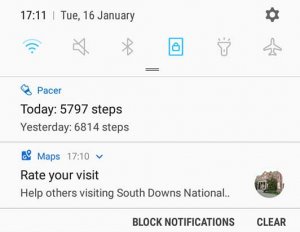
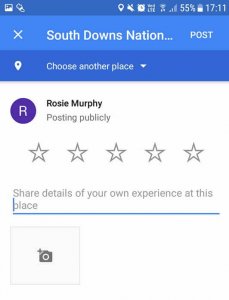 This means users are encouraged to submit regular, ‘everyday’ reviews just because they are asked to – rather than seeking out a business on a review site due to a notably good or bad experience.
This means users are encouraged to submit regular, ‘everyday’ reviews just because they are asked to – rather than seeking out a business on a review site due to a notably good or bad experience.
Number of New Reviews Written Per Month (July 2016 – July 2017)
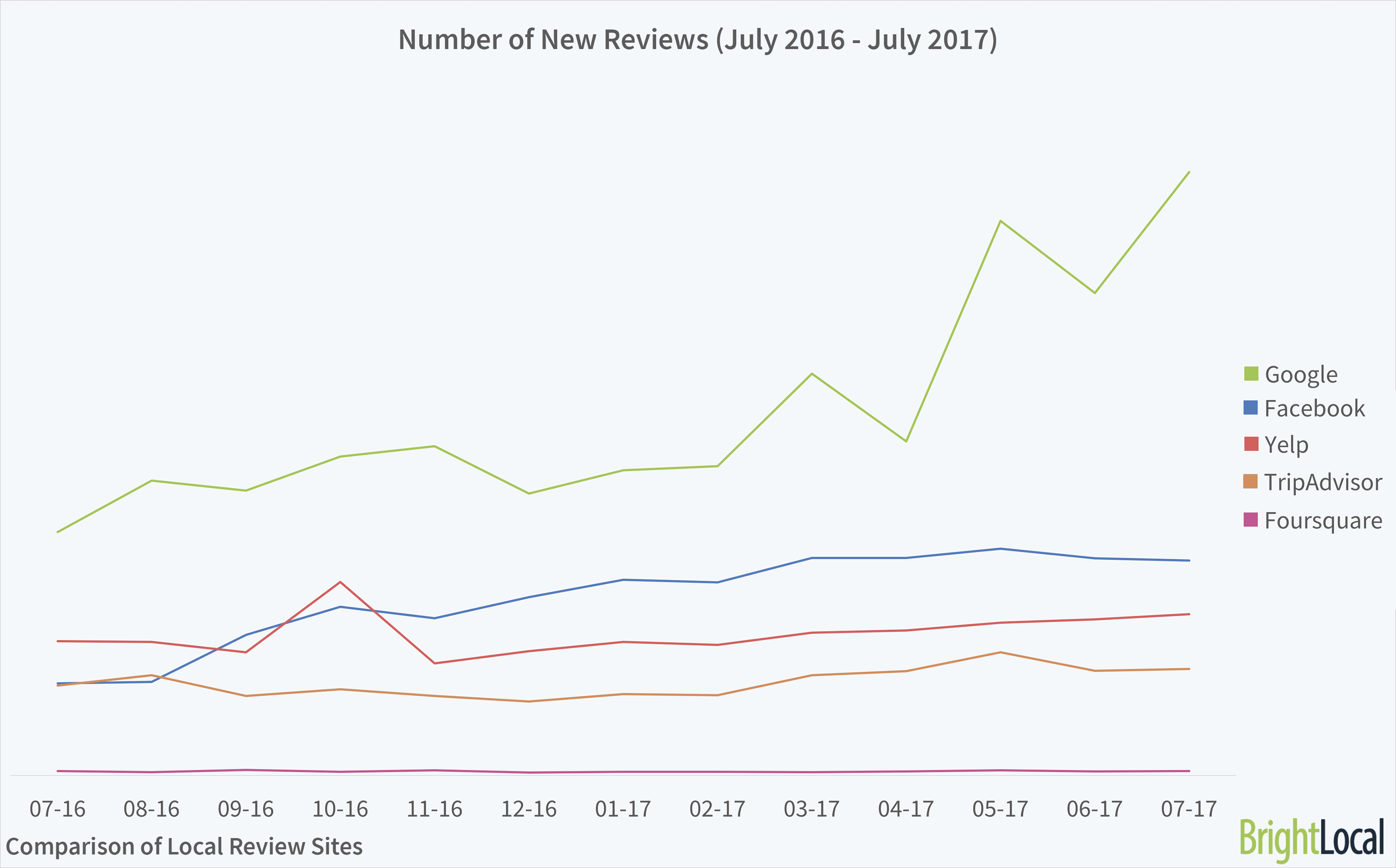
The period July 2016 – July 2017 highlights a number of trends across the review platforms in greater detail. We delved into the number of reviews each platform gained every month in that period.
- Google continued to lead in the number of new reviews – with significant increases in 2017
- Facebook also saw strong growth in this period – but at a slower pace than Google
- TripAdvisor and Yelp grew slowly and steadily
Generally, the months in our time period in 2017 outperformed the months in 2016 – signifying further acceleration of growth for most of the review sites.
Google saw a significant increase in the number of new reviews – pulling quickly ahead to leave everyone else in the dust. It saw a 40% increase from April to May 2017 in the number of new reviews per month. While there was a small drop the next month, this ramped up again in July. By July 2017, the businesses were receiving more than double the amount of new reviews they were just a year before.
On Facebook, the businesses in our sample saw a significant growth in the number of new reviews from September 2016 – growing 33% in just one month. Between August and December, it more than doubled the number of reviews per month – and continued growing in 2017. Our sample suggests that Facebook has lots to be proud of in this time period – growing from a similar number of reviews as TripAdvisor in July 2016, to an increase of 133% a year on.
Curiously, May 2017 proved to be a great month for Google, Facebook, and TripAdvisor. If you’ve got any thoughts on why this might be, leave us a comment below.
Perhaps unsurprisingly, there appears to be a summer peak for TripAdvisor, with August, July and October leading in 2016 – although the months March to July 2017 outperform every month in 2016. It’s no surprise that this correlates with the high season for holidays and trips out.
Yelp received a steady number of reviews – performing well throughout the time period with a surprise peak in October 2016 that even overtook Facebook for the month. It soon dropped back to its former position, with a slow and steady increase in the number of reviews each month.
Foursquare was the only platform of the five that didn’t show a clear trend of increased reviews over the time period. But with these numbers being a fraction of their nearest competitor, the lack of correlation is not a shock.
Trends by Review Site
Google Reviews

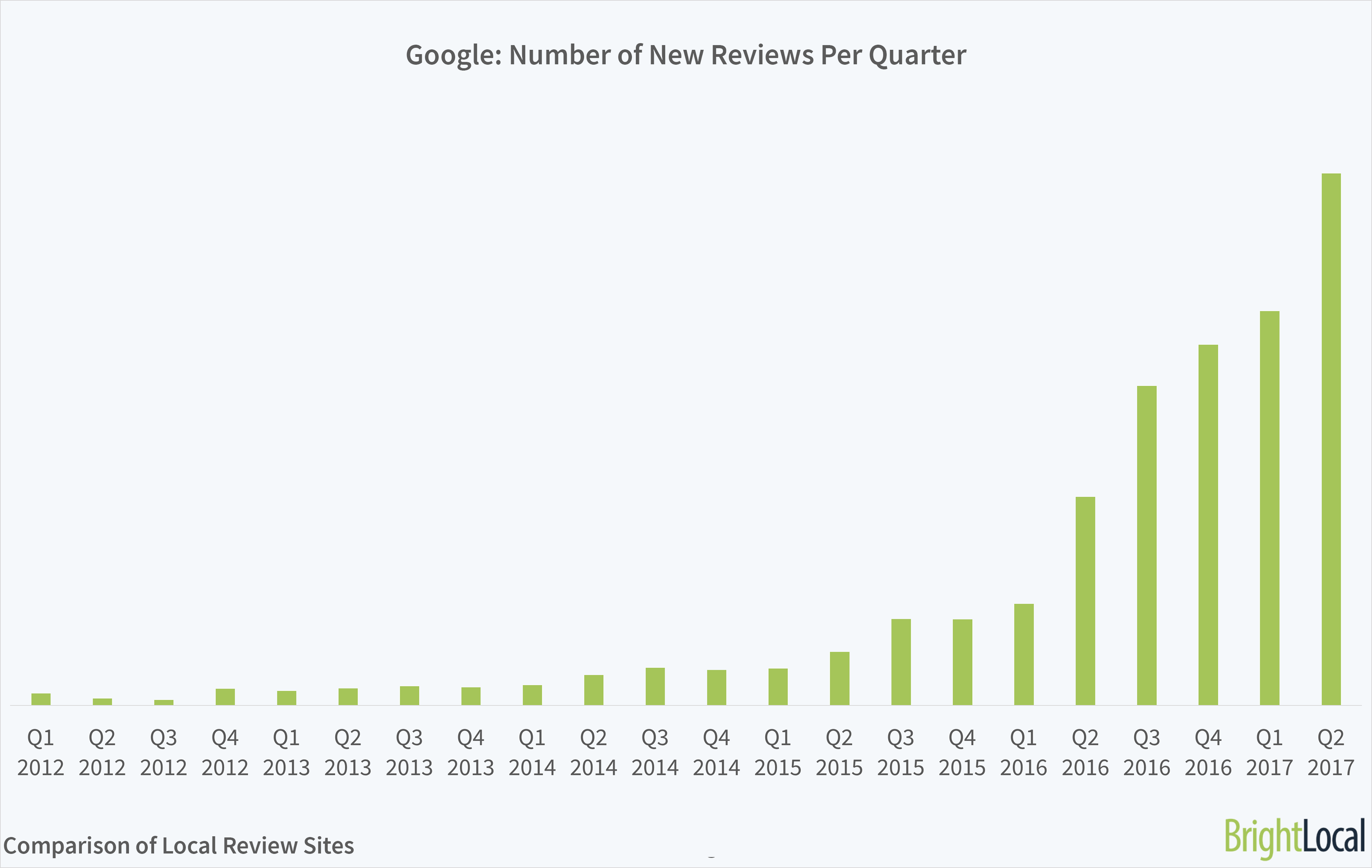
Google has told an interesting story, placing third for number of reviews in 2014 and 2015, and jumping into pole position from 2016. The businesses in the study saw a huge uplift in reviews in Google – seeing an increase of 278% in 2016 from the year before, and acquiring significantly more in the first half of 2017. While it may have had a slow start, the powerhouse is growing every quarter to lead in numbers of reviews.
From the days of Hotpot, Google has placed itself as a source of recommendations. So much information is now available in SERPs and the Google environment, it’s no wonder reviewers are choosing the platform that is so useful and prominent during the research process.
Google’s stellar growth should be attributed to its growing omnipresence. It’s become a normal part of finding local businesses, and makes it incredibly easy for people to leave reviews.
However, our recent Local Consumer Review Survey found that Google is consumers’ third most trusted review site – behind Facebook and Yelp. While our Review Growth data shows Google’s rapid growth to becoming the leading platform in number of reviews, there’s still work to be done in aligning this with the trust of users.
Facebook Reviews
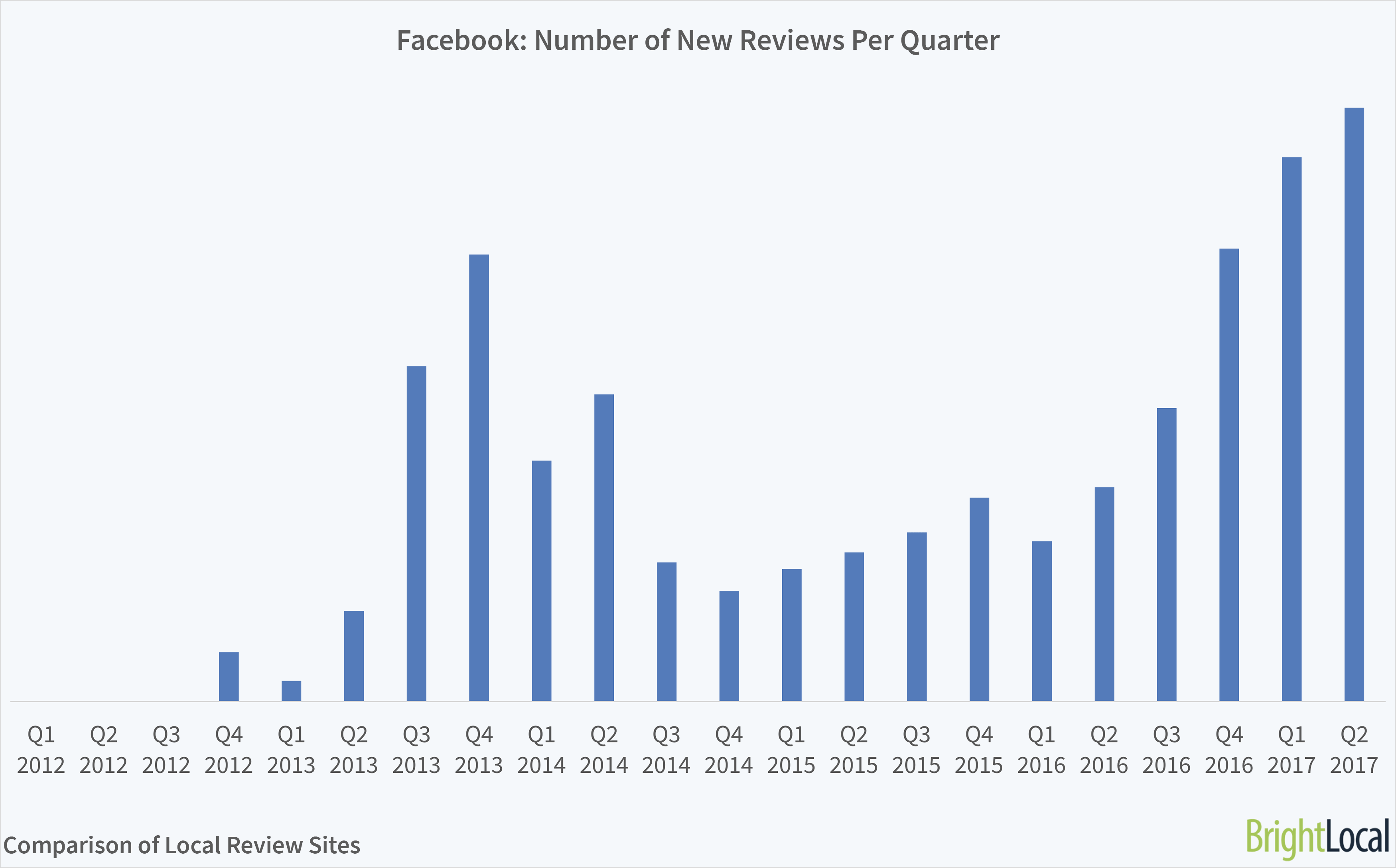
Facebook reviews rapidly took off following their introduction in late 2012. The December 2012 announcement of Nearby meant users could share their recommendations easily with friends for the first time, explaining the rapid percentage growth as seen in 2013.
In 2013 and 2014, Facebook led on reviews – with businesses clearly clamoring to be on the popular platform. But from 2015, Facebook could no longer rely on being the most popular source of reviews.
Don’t worry though, Facebook isn’t failing – it’s just growing at a slower rate than frontrunner Google. By November, Facebook had achieved growth of 64% on 2016. It’s not losing out as more consumers turn to Google – but could begin to receive fewer reviews in 2018 if it doesn’t encourage users to share their views.
Facebook’s recent news feed changes could affect the visibility of publishers and brands, and instead give more prominence to posts that generate discussions. This could affect which businesses users see. This could mean local businesses need to increase Facebook paid advertising, or turn to the Facebook Local app to continue being seen on the platform by potential customers.
Facebook Local is a separate app which has so far seen limited success. The Google Play Store estimates downloads as between 100,00 – 500,000 (January 2018) – far lower than Yelp’s 10-50 million Android users, or TripAdvisor’s 100-500 million. It will need to reverse this trend to continue to be a trusted platform for reviews.
Yelp Reviews
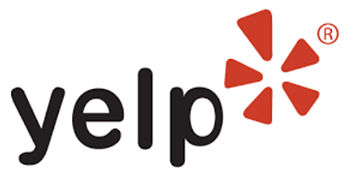
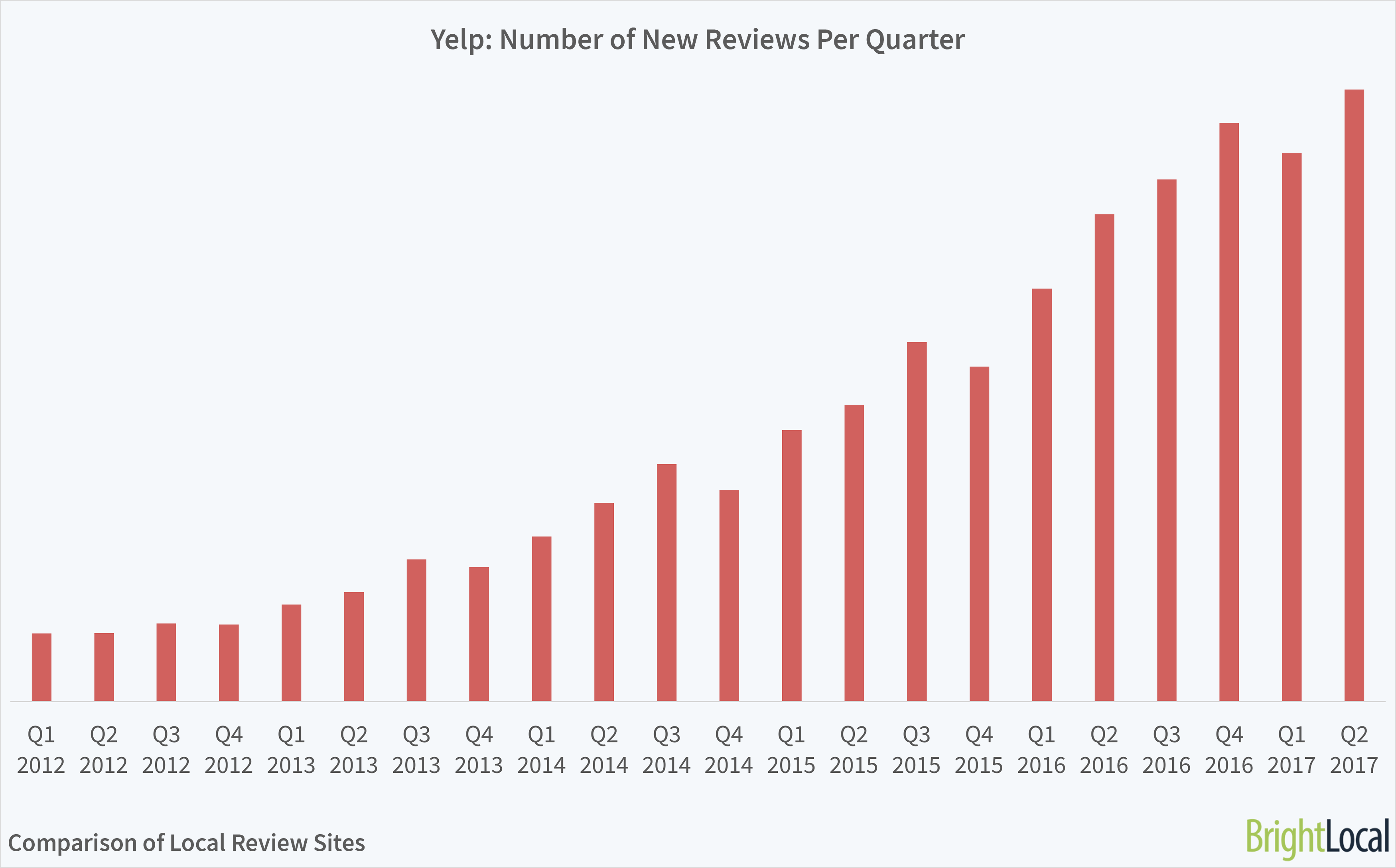 Yelp has been a steady performer over the years, but its growth appears to have slowed recently. In each year prior to 2017, Yelp reviews grew between 55% and 68% on the previous year. It received fewer new reviews in Q1 of 2017 than in the previous quarter, although this did grow again in Q2.
Yelp has been a steady performer over the years, but its growth appears to have slowed recently. In each year prior to 2017, Yelp reviews grew between 55% and 68% on the previous year. It received fewer new reviews in Q1 of 2017 than in the previous quarter, although this did grow again in Q2.
2016 was a difficult year for Yelp, with the platform announcing a scaleback in operations outside North America, and culling further international expansion plans. In May 2017, Yelp’s stocks dropped by 30%after showing disappointing sales.
These recent difficulties appear to be in line with the smaller growth in new reviews – and could indicate that Yelp have recognized their troubles ahead of the review downturn. But, it’s not all bad news, as it is still growing – albeit at a slower rate – with May, June, and July 2017 each surpassing every month before in the number of reviews received on the site.
The big news from Yelp in 2017 was its firm stance on businesses asking for customer reviews. While authenticity should be paramount to any review strategy, actively discouraging asking for these could result in Yelp receiving fewer reviews going forwards. It’s highly possible that businesses will turn to other review sites, rather than stopping asking customers to leave reviews at all.
Tripadvisor Reviews
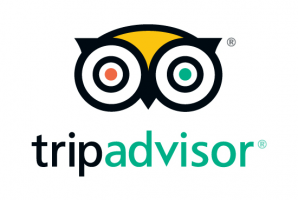
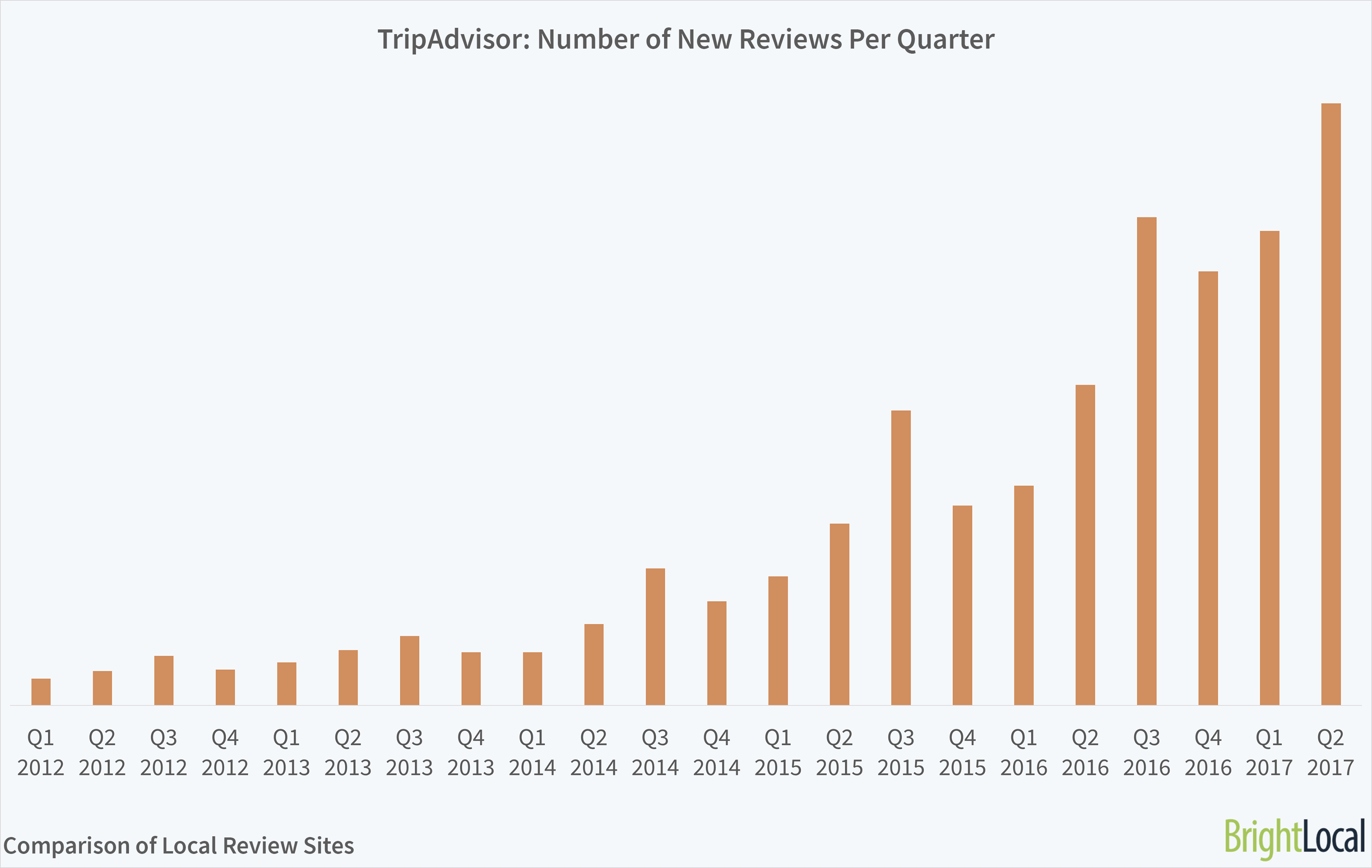
Due to its niche focus, it’s no surprise that TripAdvisor doesn’t acquire as many reviews as Google, Facebook, and Yelp. The travel specialist appears to be slowing in percentage growth – but it is still growing! In 2015, the number of reviews grew 115% on the year before, and a further 82% 2015-2016. It had a particularly strong Q2 in 2017 in the number of new reviews.
As a business, TripAdvisor had a tumultuous 2017, with results falling below analysts’ estimates. The Financial Times reported that “TripAdvisor shares have declined 15 per cent so far this year amid concerns that the company will struggle to turn audience growth into revenue growth.” It’ll be interesting to see if these difficulties reflect in future new reviews on the platform.
Niche review sites may attract fewer total reviews than the big three review platforms do, but they’re still incredibly important within industry sectors. Local businesses should ensure they receive reviews across each of the relevant platforms – making sure to consider where their customers and audiences are looking to find out more.
Foursquare Reviews

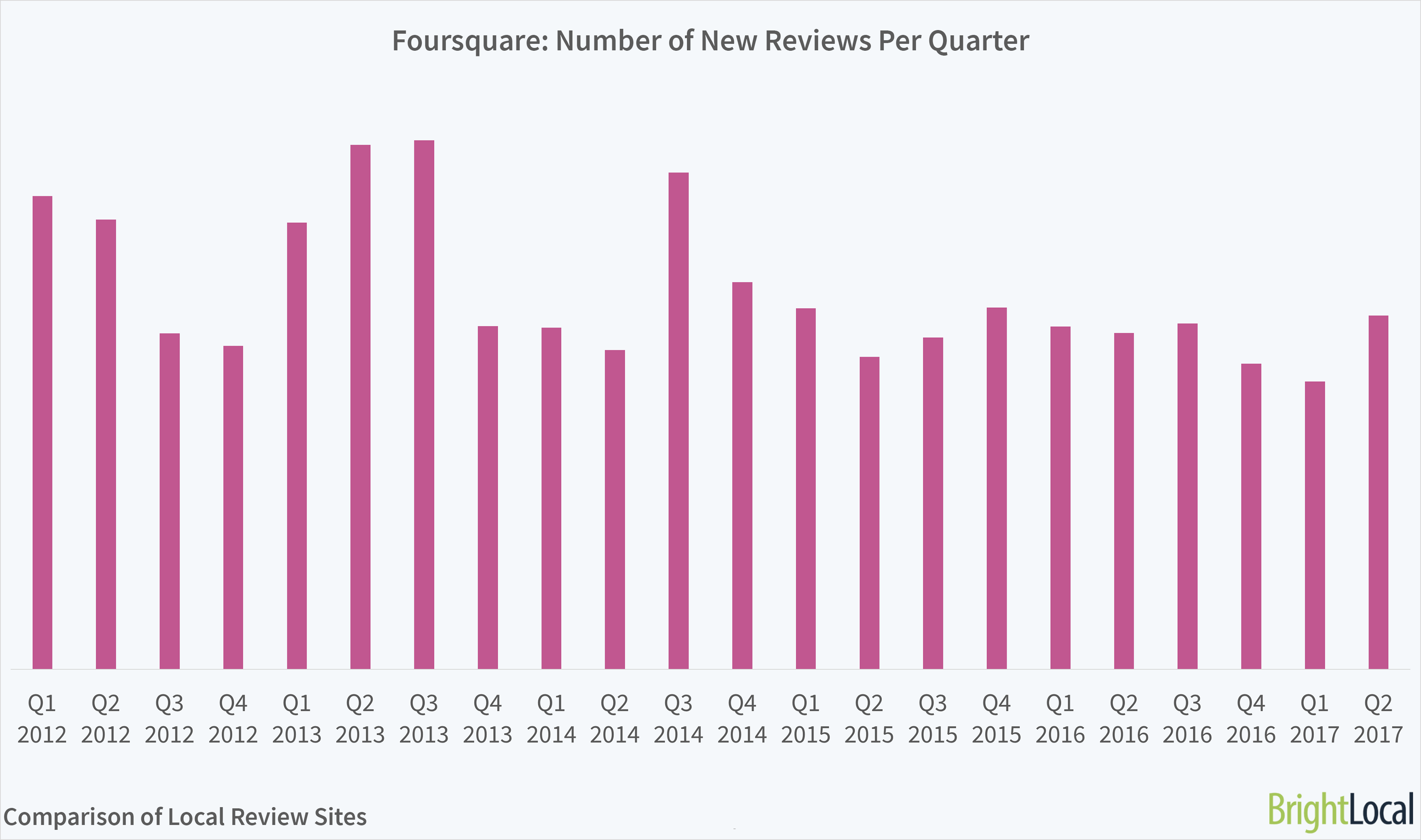
Foursquare’s comparatively low reviews rates will come as no shock. While it no longer competes as a leading reviews platform, it instead excels with its incredibly accurate location data. There have been predictions about Foursquare ending its focus on consumer recommendations, and instead selling its significant data set. Its future remains to be seen.
Loyal users of City Guide can use Foursquare’s data set to find recommendations where they are – although clearly there are fewer reviews per business than other platforms offer. The average consumer reads 7 reviews before trusting a business, so Foursquare might not be the place to go to receive sufficient information.
How Traditional and Digital Marketing Work Together to Power Your Business Goals

Traditional marketing has drastically changed through the evolution of the digital age, and the societal integration of social media. The past 15 years of revolutionary change has caused confusion, doubt, and misunderstanding. Leaving many marketers in the lurch as they attempt to navigate in an ever-changing advertising landscape.
As a result, some are ditching traditional methods completely in hopes of online techniques bringing them holy grail-like ROIs they once experienced. According to Above the Fold’s Traditional Media Strategist Charlie DeNatale, “Traditional media is not broken. What needs to be fixed is the mindset change of what traditional media’s role use to be and what its role is today.”
While digital media strategy is highly important and necessary for producing results and to compete, using a combination of traditional and digital marketing techniques is proving to be the most effective method to elevating success.
The combination of traditional and digital is a one two punch for driving awareness and sales. When combined, they compensate for each other’s weaknesses and so the benefits of both plans are gained as they work in synchronicity.
How to Marry Traditional and Digital Marketing
1. Multiple Channel Approach
By taking advantage of a wider range of traditional and digital techniques, you’re putting your company’s message in front of a diversified audience. For example, a placement during on a cable network like the Hallmark Channel will most likely reach an older audience, while a placement during a teen drama on Hulu will hit a chord with a younger audience.

Depending on the target, some media outlets and types are more successful than others, especially when you consider that a younger audience is more digitally savvy than say their parents’ generation. Using both methods allows your company to reach the full spectrum of potential customers.
One brand that seamlessly integrates both a traditional and digital strategy is fast food chain, Wendy’s. Through their social channels they’ve built a rabid following, eager to consume and interact with the brand through their regular roasting of competing brands and Twitter followers. Their savage tweets have brought a whole new generation of Wendy’s fans and patrons into the fold. They also regularly utilize traditional channels like TV commercials, print, and billboards to attract new and old customers to their restaurants.
2. Segment Campaigns by Active & Passive
Figure out first what your company’s objectives are with your campaign. Is it brand awareness? Driving sales to a new product offering? Introducing your brand to a new generation?
Then you can segment your campaign strategy based upon the activity of the consumer. Traditional marketing is considered to be passive, while digital marketing involves targeting a specific audience, making it active.
While they may be segmented by audience or purpose, they can still maintain a common thread to boost the success of the campaign’s overall goals.
One common thread could be a hashtag. Ask your social followers to take a picture with your product and use the hashtag to be featured or win a contest. Place this same hashtag in our traditional media placements to spread it far and wide, giving it visibility beyond the digital sphere.
3. Get Personal
The amazing result of digital marketing is how its given brands and small businesses the ability to connect with consumers at a deeper personal level. Gone are the days where a customer has to go through the customer service department to get a question answered or a problem resolved. All they have to do is leave an Instagram comment or Tweet at the business and typically within no time they’re getting a direct reply from the company; building trust and affinity.
With social media’s personal touch it’s now more important than ever to have a strategic approach when considering traditional media. Not just what you buy, but how you buy it, how it supports a digital campaign and the influence it has on SEO, PPC, website traffic, and sales.

A great example of a company using traditional and digital to get more personal with their consumers is online fashion retailer, Asos. They release a regular Asos Magazine that features not only their latest fashions and product offerings, but articles related to pop culture, rising stars and musical acts, and other millennial targeted pieces.
Every item featured in the magazine can then be found on a dedicated page titled, “Shop the Asos Magazine.” This gives the reader the chance to emulate their favorite starlet or take the look from the page, and wear it in real life.
It’s a strategy that’s working. Especially when coupled with their hashtag #asseenonme, which encourages their followers to use the hashtag with their Asos look for a chance to be featured on their 6.7M follower Instagram account.
How good is the hashtag working? To the sound of 676,609 photos and counting. Getting personal is the key to building a cult following, or at the very least an audience that’s dedicated to your brand.
In the End, Take a Holistic Approach
Shrewdly evaluate your current traditional and digital efforts with a holistic approach. Understand the “Balance” of your budget allocation between traditional and digital. Use the techniques together to create a cohesive marketing strategy that drives tangible results for your business. If you’re not using both than your business may not be attracting all of your potential customers.
Above the Fold can help you apply these techniques and develop a strategic traditional and digital marketing plan. Contact us today at 760.613.1212 to learn more!
The Top 99 Marketing Terms You Should Know

Above The Fold Agency thought it was time to provide a holistic marketing glossary – Here are the top 99 terms that are imperative to anyone learning about marketing. We hope this helps you through your journey…
A
1) A/B Testing
This is the process of comparing two variations of a single variable to determine which performs best in-order-to help improve marketing efforts. This is often done in email marketing (with variations in the subject line or copy), calls-to-action (variations in colors or verbiage), and landing pages (variations in content).
2) Analytics
Analytics is essentially the discovery and communication of meaningful patterns in data. When referred to in the context of marketing, it’s looking at the data of one’s initiatives (website visitor reports, social, PPC, etc.), analyzing the trends, and developing actionable insights to make better informed marketing decisions.
3) Application Programming Interface (API)
APIs are a series of rules in computer programming, which allow an application to extract information from a service and use that information either in their own application or in data analyses. It’s kind of like a phone for applications to have conversations — an API literally “calls” one application and gets information to bring to you to use in your software. APIs facilitate the data needed to provide solutions to customer problems.
B
4) B2B (Business-to-Business)
An adjective used to describe companies that sell to other businesses. For example, Google and Oracle are primarily B2B companies.
5) B2C (Business-to-Consumer)
An adjective used to describe companies that sell directly to consumers. For example, Amazon, Apple, and Nike are primarily B2C companies.
6) Blogging
This is short for web log or weblog. An individual or group of people usually maintains a blog. A personal blog or business blog will traditionally include regular entries of commentary, descriptions of events, or other material, such as photos and video.
Blogging is a core component of inbound marketing, as it can accomplish several initiatives simultaneously — like website traffic growth, thought leadership, and lead generation. It does not, however, do your taxes.
7) Business Blogging
Business blogging retains all the attributes of “regular” blogging, but adds a tasty layer of marketing strategy on top. It helps marketers drive traffic to their website, convert that traffic into leads, establish authority on certain topics, and drive long-term results.
When blogging for a business, marketers should create posts that are optimized with keywords that their target audience is searching for and provide helpful, educational material to these readers. Typically, these blog posts should be actionable (by providing an opt-in, downloadable offer), as to provide a metric for the effectiveness of the business blogging.
8) Bottom of the Funnel
The bottom of the funnel refers to a stage of the buying process leads reach when they’re just about to close as new customers. They’ve identified a problem, have shopped around for possible solutions, and are very close to buying.
Typically, next steps for leads at this stage are a call from a sales rep, a demo, or a free consultation — depending on what type of business is attempting to close the lead.
9) Bounce Rate
Website bounce rate: The percentage of people who land on a page on your website and then leave without clicking on anything else or navigating to any other pages on your site. A high bounce rate generally leads to poor conversion rates because no one is staying on your site long enough to read your content or convert on a landing page (or for any other conversion event).
Email bounce rate: The rate at which an email was unable to be delivered to a recipient’s inbox. A high bounce rate generally means your lists are out-of-date or purchased, or they include many invalid email addresses. In email, not all bounces are bad, so it’s important to distinguish between hard and soft bounces before taking an email address off your list.
10) Buyer Persona
A semi-fictional representation of your ideal customer based on market research and real data about your existing customers. While it helps marketers like you define their target audience, it can also help sales reps qualify leads.
C
11) Call-to-Action
A call-to-action is a text link, button, image, or some type of web link that encourages a website visitor to visit a landing page and become of lead. Some examples of CTAs are “Subscribe Now” or “Download the Whitepaper Today.” These are important for marketers because they’re the “bait” that entices a website visitor to eventually become a lead. So, you can imagine that it’s important to convey a very enticing, valuable offer on a call-to-action to better foster visitor-to-lead conversion.
12) CAN-SPAM
CAN-SPAM stands for “Controlling the Assault of Non-Solicited Pornography and Marketing.” It’s a U.S. law passed in 2003 that establishes the rules for commercial email and commercial messages, it gives recipients the right to have a business stop emailing them, and outlines the penalties incurred for those who violate the law. For example, CAN-SPAM is the reason businesses are required to have an “unsubscribe” option at the bottom of every email.
13) CASL
CASL stands for “Canadian Anti-Spam Legislation.” It’s a Canadian law passed in 2013 that covers the sending of “commercial electronic messages” that may be accessed by a computer in Canada. CASL covers email, texts, instant messages, and automated cell phone messages sent to computers and phones in Canada.
14) Churn Rate
A metric that measures how many customers you retain and at what value. To calculate churn rate, take the number of customers you lost during a certain time frame, and divide that by the total number of customers you had at the very beginning of that time frame. (Don’t include any new sales from that time frame.)
For example, if a company had 500 customers at the beginning of October and only 450 customers at the end of October (discounting any customers that were closed in October), their customer churn rate would be: (500-450)/500 = 50/500 = 10%.
15) Click-Through-Rate (CTR)
The percentage of your audience that advances (or clicks through) from one part of your website to the next step of your marketing campaign. As a mathematic equation, it’s the total number of clicks that your page or CTA receives divided by the number of opportunities that people had to click (ex: number of page views, emails sent, and so on).
16) Closed-Loop Marketing
The practice of closed-loop marketing is being able to execute, track and show how marketing efforts have impacted bottom-line business growth. An example would be tracking a website visitor as they become a lead to the very last touch point when they close as a customer.
17) Conversion Path
A conversion path is a series of website-based events that facilitate lead capture. In its most basic form, a conversion path will consist of a call-to-action (typically a button that describes an offer) that leads to a landing page with a lead capture form, which redirects to a thank you page where a content offer resides. In exchange for his or her contact information, a website visitor obtains a content offer to better help them through the buying process.
18) Content
In relation to inbound marketing, content is a piece of information that exists for the purpose of being digested (not literally), engaged with, and shared. Content typically comes in the form of a blog, video, social media post, photo, slideshow, or podcast, although there are plenty of over types out there. From website traffic to lead conversion to customer marketing, content plays an indispensable role in a successful inbound marketing strategy.
19) Content Management System (CMS)
A web application designed to make it easy for non-technical users to create, edit, and manage a website. Helps users with content editing and more “behind-the-scenes” work like making content searchable and indexable, automatically generating navigation elements, keeping track of users and permissions, and more.
20) Content Optimization System (COS)
A COS is basically a CMS (Content Management System), but optimized to deliver customers the most personalized web experience possible.
21) Context
If content is king, then context is queen. Serving up valuable content is important, but ensuring that it’s customized for the right audience is equally (if not more) important. As buyers become more in control of what information they digest (again, not literally), it’s important to deliver content that’s contextually relevant.
22) Conversion Rate
The percentage of people who completed a desired action on a single web page, such as filling out a form. Pages with high conversion rates are performing well, while pages with low conversion rates are performing poorly.
23) Conversion Rate Optimization (CRO)
The process of improving your site conversion using design techniques, key optimization principles, and testing. It involves creating an experience for your website visitors that will convert them into customers. CRO is most often applied to web page or landing page optimization, but it can also be applied to social media, CTAs, and other parts of your marketing.
24) Cost-Per-Lead (CPL)
The amount it costs your marketing organization to acquire a lead. This factors heavily into CAC (customer acquisition cost), and is a metric marketers should keep a keen eye on.
25) Crowdsourced Content
Creating your own content can take more time than you have to lend to it — which is where crowdsourcing comes into play. Allowing subject matter experts, customers, or freelancers to create your content for you is a prime way to get more quality content published in less time. Compile the content you get back into a really awesome offer and give credit to all the contributors — a win-win for everyone involved.
26) Customer Acquisition Cost (CAC)
Your total Sales and Marketing cost. To calculate CAC, follow these steps for a given time period (month, quarter, or year):
- Add up program or advertising spend + salaries + commissions + bonuses + overhead.
- Divide by the number of new customers in that time period.
For example, if you spend $500,000 on Sales and Marketing in a given month and added 50 customers that same month, then your CAC was $10,000 that month.
27) Customer Relationship Management (CRM)
A set of software programs that let companies keep track of everything they do with their existing and potential customers.
At the simplest level, CRM software lets you keep track of all the contact information for these customers. But CRM systems can do lots of other things, too, like tracking email, phone calls, faxes, and deals; sending personalized emails; scheduling appointments; and logging every instance of customer service and support. Some systems also incorporate feeds from social media such as Facebook, Twitter, LinkedIn, and others.
28) CSS
CSS stands for Cascading Style Sheets, and it’s what gives your entire website its style, like colors, fonts, and background images. It affects the mood and tone of a web page, making it an incredibly powerful tool. It’s also what allows websites to adapt to different screen sizes and device types.
D
29) Dynamic Content
A way to display different messaging on your website based on the information you already know about the visitor. For example, you could use Smart CTAs so that first-time visitors will see a personalized CTA (perhaps with a top-of-the-funnel offer) and those already in your database see a different CTA (maybe for content that offers a little more information about your product or service).
E
30) E-book
E-books are a common type of content that many marketers use, often to help generate leads. They are generally a more long-form content type than, say, blog posts, and go into in-depth detail on a subject.
31) Editorial Calendar
It’s like a road map for content creation, showing you what kind of content to create, what topics to cover, which personas to target, and how often to publish to best support your strategy. Maintaining an editorial calendar will keep you more organized and show you any gaps you may have in your content library. It also helps ensure you’re doing the right things for your personas and not going way off-track with the topics you’re covering.
32) Email
In its most basic sense, email stands for “Electronic Mail.” It’s a core component of marketing because it’s a direct connection to a contact’s inbox. However, with great power comes great responsibility, meaning it’s important for marketers to not abuse the email relationship with a contact. It’s far too easy for a contact to click “unsubscribe” after gaining their hard earned trust in your communication.
33) Engagement Rate
A popular social media metric used to describe the amount of interaction — Likes, shares, comments — a piece of content receives. Interactions like these tell you that your messages are resonating with your fans and followers.
34) Evergreen Content
Evergreen content is content that continues to provide value to readers no matter when they stumble upon it. In other words, it can be referenced long after it was originally published, and even then, it’s still valuable to the reader.
Typically, a piece of evergreen content is timeless, valuable, high quality, and canonical or definitive. These posts are typically a content marketer’s best friend because of the tremendous SEO value they provide.
F
35) Facebook
Facebook is a social network you’re likely quite familiar with already — but it has become so much more than just a platform to publish content and gain followers. You can now utilize the awesome targeting options available through Facebook advertising to find and attract brand new contacts to your website and get them to convert on your landing pages … but remember, you still need awesome content to do it.
While it’s a core component of any marketing strategy, it shouldn’t be the only component. Focusing entirely on Facebook (or any other large social channel, for that matter) will only give you a small piece of the inbound marketing pie. And it’s still piping hot, so be careful.
36) Form
The place your page visitors will supply information in exchange for your offer. It’s also how those visitors can convert into precious sales leads. As a best practice, only ask for information you need from your leads in order to effectively follow up with and/or qualify them.
37) Friction
Any element of your website that is confusing, distracting, or causes stress for visitors, causing them to leave your page. Examples of friction-causing elements include dissonant colors, too much text, distracting website navigation menus, or landing page forms with too many fields.
G
38) Google+
Google+ (referred to as “Google Plus”) is a social network that allows you to join and create circles in which you can mix and match family members, friends, colleagues, and fellow industry members. While you can use it much like other social networks — to publish and share content, and generate new leads — it also provides content marketers with tremendous SEO value due to the rising importance of social sharing in search engine algorithms.
H
39) Hashtag
Hashtags are a way for you and your readers to interact with each other on social media and have conversations about a particular piece of content. They tie public conversations on Twitter, Facebook, and Instagram together into a single stream, which users can find by searching for a hashtag, clicking on one, or using a third-party monitoring tool.
The hashtags themselves are simply a keyword phrase, spelled out without spaces, with a pound sign (#) in front of it — like #InboundChat and #ChocolateLovers. You can put these hashtags anywhere in your social media posts.
40) HTML
This is short for HyperText Markup Language, a language used to write web pages. It’s at the core of every web page, regardless the complexity of a site or number of technologies involved, and provides the basic structure of the site — which is then enhanced and modified by other technologies like CSS and JavaScript.
I
41) Inbound Marketing
Inbound marketing refers to marketing activities that draw visitors in, rather than marketers having to go out to get prospects’ attention. It’s all about earning the attention of customers, making the company easy to find online, and drawing customers to the website by producing interesting, helpful content. By aligning the content you publish with your customer’s interests, you naturally attract inbound traffic that you can then convert, close, and delight over time.
42) Inbound Link
An inbound link is a link coming from another site to your own website. “Inbound” is generally used by the person receiving the link.
Websites that receive many inbound links can be more likely to rank higher in search engines. They also help folks receive referral traffic from other websites.
43) Infographic
A highly visual piece of content that is very popular among digital marketers as a way of relaying complex concepts in a simple and visual way.
44) Instagram
Though initially a haven only for younger generations who wanted to post, edit, and share unique-looking photos, Instagram has grown into a premier social network that’s a viable opportunity for content marketers. Many businesses are taking advantage of the site by posting industry related photos that their followers and customers would enjoy seeing.
J
45) JavaScript
JavaScript is a programming language that lets web developers design interactive sites. Most of the dynamic behavior you’ll see on a web page is thanks to JavaScript, which augments a browser’s default controls and behaviors.
Uses for JavaScript include pop-ups, slide-in calls-to-action, security password creation, check forms, interactive games, and special effects. It’s also used to build mobile apps and create server-based applications.
K
46) Key Performance Indicator (KPI)
A type of performance measurement companies use to evaluate an employee’s or an activity’s success. Marketers look at KPIs to track progress toward marketing goals, and successful marketers constantly evaluate their performance against industry standard metrics. Examples of KPIs include CAC (Customer Acquisition Cost), blog traffic sources, and homepage views. Choose KPIs that represent how your marketing and business are performing.
47) Keyword
Sometimes referred to as “keyword phrases,” keywords are the topics that webpages get indexed for in search results by engines like Google, Yahoo, and Bing.
Picking keywords that you’ll optimize a webpage for is a two-part effort. First, you’ll want to ensure the keyword has significant search volume and is not too difficult to rank for. Then, you’ll want to ensure it aligns with your target audience
After deciding the appropriate keywords you want to rank for, you’ll then need to optimize the appropriate pages on your website using both on-page and off-page tactics.
L
48) Landing Page
A landing page is a website page containing a form that is used for lead generation. This page revolves around a marketing offer, such as an e-book or a webinar, and serves to capture visitor information in exchange for the valuable offer. Landing pages are the gatekeepers of the conversion path and are what separates a website visitor from becoming a lead.
A smart inbound marketer will create landing pages that appeal to different personae (plural for persona) at various stages of the buying process. A hefty endeavor no doubt, but one that pays off in spades.
49) Lead
A person or company who’s shown interest in a product or service in some way, shape, or form. Perhaps they filled out a form, subscribed to a blog, or shared their contact information in exchange for a coupon.
Generating leads is a critical part of a prospect’s journey to becoming a customer, and it falls in between the second and third stages of the larger inbound marketing methodology, which you can see below.
Landing pages, forms, offers, and calls-to-action are just a few tools to help companies generate leads.
50) Lead Nurturing
Sometimes referred to as “drip marketing,” lead nurturing is the practice of developing a series of communications (emails, social media messages, etc.) that seek to qualify a lead, keep it engaged, and gradually push it down the sales funnel. Inbound marketing is all about delivering valuable content to the right audience — and lead nurturing helps foster this by providing contextually relevant information to a lead during different stages of the buying lifecycle.
51) LinkedIn
LinkedIn is a business-oriented social networking site. Launched in May 2003, it is mainly used for professional networking. Nowadays, with more than 414 million registered members, LinkedIn is the most popular social network for professionals and one of the top social networks overall. Getting on the platform, developing a completed profile, and networking has helped many a jobseeker find work.
52) Lifecycle Stages
These divisions serve as a way to describe the relationship you have with your audience, and can generally be broken down into three stages: awareness, evaluation, and purchase.
What’s important to understand about each of these stages is that not every piece of content you create is appropriate, depending on what stage your audience might fall in at that moment. That’s why dynamic content is so great — you can serve up content that’s appropriate for whatever stage that particular visitor is in.
53) Lifetime Value (LTV)
A prediction of the net profit attributed to the entire future relationship with a customer. To calculate LTV, follow these steps for a given time-period:
- Take the revenue the customer paid you in that time-period.
- Subtract from that number the gross margin.
- Divide by the estimated churn rate (aka cancellation rate) for that customer.
For example, if a customer pays you $100,000 per year where your gross margin on the revenue is 70%, and that customer type is predicted to cancel at 16% per year, then the customer’s LTV is $437,500.
54) Long-Tail Keyword
A long-tail keyword is a very targeted search phrase that contains three or more words. It often contains a head term, which is a more generic search term, plus one or two additional words that refine the search term. For example:
- Head term: unicorn
- Long-tail keywords: unicorn games online, unicorn costumes for kids,
Long-tail keywords are more specific, which means visitors that land on your website from a long-tail search term are more qualified, and consequently, more likely to convert.
55) LTV:CAC
The ratio of lifetime value (LTV) to customer acquisition cost (CAC). Once you have the LTV and the CAC, compute the ratio of the two. If it costs you $100,000 to acquire a customer with an LTV of $437,500, then your LTV:CAC is 4.4 to 1.
M
56) Marketing Automation
While there’s some overlap with the term “lead nurturing,” marketing automation is a bit different. Think of marketing automation as the platform with associated tools and analytics to develop a lead nurturing strategy. If you’ll let me run with an “art” analogy, marketing automation is the paintbrush, watercolors, and blank canvas. Lead nurturing is the artist that makes it all come together. Like Bob Ross! You can’t paint a happy little nurturing campaign without both.
Bonus: Want to get super-savvy with your marketing automation terminology? Take it to the next level with behavior-based marketing automation. Behavior-based marketing automation refers to a system that triggers emails and other communication based on user activity on and off your site. It enables marketers to nurture leads and send them information only when it is most relevant to their stage in the buying cycle.
57) Microsite
A cross between a landing page and a “regular” website. ElfYourself.com is a great example. Microsites are used when marketers want to create a different online experience for their audience separate from their main website. These sites often have their own domain names and distinct visual branding.
58) Middle of the Funnel
This refers to the stage that a lead enters after identifying a problem. Now they’re looking to conduct further research to find a solution to the problem. Typical middle of the funnel offers include case studies or product brochures — essentially anything that brings your business into the equation as a solution to the problem the lead is looking to solve. Also, if you want to be cool, you can refer to this stage as “MOFU” for short.
59) Mobile Marketing
With mobile search queries officially surpassing desktop queries, now is probably the time to explore mobile marketing. What is it? Well, mobile marketing refers to the practice of optimizing marketing for mobile devices to provide visitors with time- and location- sensitive, personalized information for promoting goods, services, and ideas.
60) Mobile Optimization
Mobile optimization means designing and formatting your website so that it’s easy to read and navigate from a mobile device. This can be done by either creating a separate mobile website or incorporating responsive design in initial site layout. Google’s algorithm now rewards mobile-friendly websites, so if your site isn’t fully optimized for mobile devices, you will likely see a hit to your ranking on mobile searches.
61) Monthly Recurring Revenue (MRR)
The amount of revenue a subscription-based business receives per month. Includes MRR gained by new accounts (net new), MRR gained from upsells (net positive), MRR lost from down-sells (net negative), and MRR lost from cancellations (net loss).
N
62) Native Advertising
A type of online advertising that takes on the form and function of the platform it appears on. Its purpose is to make ads feel less like ads, and more like part of the conversation. That means it’s usually a piece of sponsored content that’s relative to the consumer experience, isn’t interruptive, and looks and feels similar to its editorial environment.
Native advertising can come in many forms, whether it’s radio announcers talking favorably about a product sponsoring the show, or an article about a product or company showing up in your news source.
63) Net Promoter Score (NPS)
A customer satisfaction metric that measures, on a scale of 0-10, the degree to which people would recommend your company to others. The NPS is derived from a simple survey designed to help you determine how loyal your customers are to your business.
To calculate NPS, subtract the percentage of customers who would not recommend you (detractors, or 0-6) from the percent of customers who would (promoters, or 9-10).
Regularly determining your company’s NPS allows you to identify ways to improve your products and services so you can increase the loyalty of your customers.
64) News Feed
A news feed is an online feed full of news sources. On Facebook, the News Feed is the homepage of users’ accounts where they can see all the latest updates from their friends. The news feed on Twitter is called Timeline.
65) No-Follow Link
A no-follow link is used when a website does not want to pass search engine authority to another webpage. It tells search engine crawlers not to follow or pass credit to linked websites as-a-way to avoid association with spammy content or inadvertently violating webmaster guidelines. To varying degrees, the no-follow attribute is recognized by all major search engines, like Google, Yahoo, and Bing. Not all links (and linking domains) are created equal, and a no-follow attribute helps avoid any foul play.
O
66) Offer
Offers are content assets that live behind a form on a landing page. Their primary purpose is to help marketers generate leads for your business. There are many different types of offers you could create, including e-books, checklists, cheat sheets, webinars, demos, templates, and tools.
67) On-Page Optimization
This type of SEO is based solely on a webpage and the various elements within the HTML (see “H” if you skipped here directly). Ensuring that key pieces of the specific page (content, title tag, URL, and image tags) include the desired keyword will help a page rank for that particular phrase.
68) Off-Page Optimization
Off-page SEO refers to incoming links and other outside factors that impact how a webpage is indexed in search results. Factors like linking domains and even social media play a role in off-page optimization. The good news is that it’s powerful; the not so good news is that it’s mostly out of an inbound marketer’s control. The solution? Create useful, remarkable content and chances are people will share and link to it.
P
69) Page View
A request to load a single web page on the internet. Marketers use them to analyze their website and to see if any change on the webpage results in more or fewer page views.
70) Pay-per-Click (PPC)
The amount of money spent to get a digital advertisement clicked. Also an internet advertising model where advertisers pay a publisher (usually a search engine, social media site, or website owner) a certain amount of money every time their ad is clicked. For search engines, PPC ads display an advertisement when someone searches for a keyword that matches the advertiser’s keyword list, which they submit to the search engine ahead of time.
PPC ads are used to direct traffic to the advertiser’s website, and PPC is used to assess the cost effectiveness and profitability of your paid advertising campaigns.
There are two ways to pay for PPC ads:
- Flat rate: where the advertiser and publisher agree on a fixed amount that will be paid for each click. Typically this happens when publishers have a fixed rate for PPC in different areas on their website.
- Bid-based: where the advertiser competes against other advertisers in an advertising network. In this case, each advertiser sets a maximum spend to pay for a given ad spot, so the ad will stop appearing on a given website once that amount of money is spent. It also means that the more people that click on your ad, the lower PPC you’ll pay and vice versa.
71) Pinterest
Pinterest is a visual social network typically used by ecommerce marketers, but not without its fair share of top-notch B2B and B2C content marketers. Businesses and consumers alike use the website to post images and photos they like so fellow users can repin (share) that content.
72) PPC
PPC, (or Pay-Per-Click) is an advertising technique in which an advertiser puts an ad in an advertising venue (like Google AdWords or Facebook), and pays that venue each time a visitor clicks on the ad.
Q
73) Qualified Lead
A contact that opted in to receive communication from your company, became educated about your product or service, and is interested in learning more.
74) QR Code
A QR code (abbreviated from Quick Response code) is a specific matrix barcode (or two-dimensional code) that is readable by dedicated QR barcode readers and camera telephones. The code consists of black modules arranged in a square pattern on a white background. The information encoded may be text, URL, or other data. It also starts with “Q,” which is a rarity with marketing-related terms.
R
75) Responsive Design
This is the practice of developing a website that adapts accordingly to how someone is viewing it. Instead of building a separate, distinct website for each specific device it could be viewed on, the site recognizes the device that your visitor is using and automatically generates a page that is responsive to the device the content is being viewed on — making websites always appear optimized for screens of any dimension.
76) Return on Investment (ROI)
A performance measure used to evaluate the efficiency and profitability of an investment, or to compare the efficiency and profitability of multiple investments. The formula for ROI is: (Gain from Investment minus Cost of Investment), all divided by (Cost of Investment). The result is expressed as a percentage or ratio. If ROI is negative, then that initiative is losing the company money. The calculation can vary depending on what you input for gains and costs.
Today, marketers want to measure the ROI on every tactic and channel they use. Many facets of marketing have pretty straightforward ROI calculations (like PPC), but others are more difficult
77) Retweet
A re-posting of a tweet posted by another user on Twitter. Retweets look like normal tweets except for the retweet icon. They can be done in three ways:
1) You can retweet an entire tweet by clicking the retweet button.
2) You can post a new tweet that includes your own commentary. In a new tweet, which also features the original tweet. It means you’ve pressed the rotating arrow icon to retweet a post, and then added a comment in the text box provided. We prefer this method of retweeting because it allows you to add your own thoughts. (Note: The retweet takes up 24 characters, leaving you with 116 characters for the comment.)
3) You can post a new tweet that includes your own commentary in addition to the information you’re retweeting. The formula is this: Your own commentary + RT + the original tweeter’s Twitter handle + colon + the exact text from their original tweet. This method of retweeting allows you to add your own thoughts, but with a very limited character count.
When you see “Please RT” in someone’s tweet, it means they are requesting that their followers retweet that tweet to spread awareness.
S
78) Search Engine Optimization (SEO)
The practice of enhancing where a webpage appears in search results. By adjusting a webpage’s on-page SEO elements and influencing off-page SEO factors, an inbound marketer can improve where a webpage appears in search engine results.
There are a ton of components to improving the SEO of your site pages. Search engines look for elements including title tags, keywords, image tags, internal link structure, and inbound links — and that’s just to name a few. Search engines also look at site structure and design, visitor behavior, and other external, off-site factors to determine how highly ranked your site should be in the search engine results pages.
79) Sender Score
An email marketing term that refers to a reputation rating from 0-100 for every outgoing mail server IP address. Mail servers will check your Sender Score before deciding what to do with your emails. A score of over 90 is good.
80) Service Level Agreement (SLA)
For marketers, an SLA is an agreement between a company’s sales and marketing teams that defines the expectations Sales has for Marketing and vice versa. The Marketing SLA defines expectations Sales has for Marketing with regards to lead quantity and lead quality, while the Sales SLA defines the expectations Marketing has for Sales on how deeply and frequently Sales will pursue each qualified lead.
SLAs exist to align sales and marketing. If the two departments are managed as separate silos, the system fails. For companies to achieve growth and become leaders in their industries, it is critical that these two groups be properly integrated.
81) Small-to-Medium Business (SMB)
Usually defined as companies that have between 10 and 500 employees.
82) Smarketing
A fun phrase used to refer to the practice of aligning Sales and Marketing efforts. In a perfect world, marketing would pass off tons of fully qualified leads to the sales team, who would then subsequently work every one of those leads enough times to close them 100% of the time. But since this isn’t always how the cookie crumbles, it’s important for Marketing and Sales to align efforts to impact the bottom line the best they can through coordinated communication.
83) Snapchat
A social app that allows users to send and receive time-sensitive photos and videos known as “snaps,” which are hidden from the recipients once the time limit expires. (Note: Images and videos still remain on the Snapchat server). Users can add text and drawings to their snaps and control the list of recipients in which they send them to.
A Snapchat story is a string of Snapchats that lasts for 24 hours. Users can create stories to be shared with all Snapchatters or just a customized group of recipients.
84) Social Media
Social media is media designed to be disseminated through social interaction, created using highly accessible and scalable publishing techniques. Facebook, Twitter, YouTube, LinkedIn and Google+ are examples of social media networks that one can join for personal or business use. Social Media is a core component of Inbound, as it provides marketers with additional channels to spread reach, increase growth, and reach business goals.
85) Social Proof
Social proof refers to a psychological phenomenon in which people seek direction from those around them to determine how they are supposed to act or think in a given situation. It’s like when you see a really long line outside a nightclub and assume that club is really good because it’s in such high demand. In social media, social proof can be identified by the number of interactions a piece of content receives or the number of followers you have. The idea is that if others are sharing something or following someone, it must be good.
86) Software-as-a-Service (SaaS)
Any software that is hosted by another company, which stores your information in the cloud. Examples: HubSpot, Salesforce, IM clients, and project management applications.
T
87) Top of the Funnel
Sometimes called “TOFU”, top of the funnel refers to the very first stage of the buying process. Leads at this stage are just identifying a problem that they have and are looking for more information. As such, an inbound marketer will want to create helpful content that aids leads in identifying this problem and providing next steps toward a solution.
88) Twitter
For the sake of creativity, I’ll define Twitter in 140 characters or less: “Twitter is a platform that allows users to share 140-character long messages publicly. User can follow one another and be followed back.”
U
89) Unique Visitor
A person who visits a website more than once within a period of time. Marketers use this term in contrast with overall site visits to track the amount of traffic on their website. If only one person visits a webpage 30 times, then that web page has one UV and 30 total site visits.
90) URL
This is short for Uniform Resource Locator. I honestly didn’t know that before writing this definition. Basically, this is the address of a piece of information that can be found on the web such as a page, image, or document (ex. http://www.huspot.com). URLs are important for on-page SEO, as search engines scour the included text when mining for keywords. If a keyword you’re looking to get indexed for is in the URL, you’ll get brownie points from search engines (but no real brownies, unfortunately).
91) User Experience (UX)
The overall experience a customer has with a particular business, from their discovery and awareness of the brand all the way through their interaction, purchase, use, and even advocacy of that brand. To deliver an excellent customer experience, you have to think like a customer, or better, think about being the customer.
92) User Interface (UI)
A type of interface that allows users to control a software application or hardware device. A good user interface provides a user-friendly experience by allowing the user to interact with the software or hardware in an intuitive way. It includes a menu bar, toolbar, windows, buttons, and so on.
V
93) Viral Content
This term is used to describe a piece of content that has become wildly popular across the web through sharing.
W
94) Website
A website is a set of interconnected webpages, usually including a homepage, generally located on the same server, and prepared and maintained as a collection of information by a person, group, or organization. An inbound marketer should structure a website like a dynamic, multi-dimensional entity that can be used to attract relevant website visitors, convert those visitors into leads, and close those leads into customers. Otherwise, it’s just a brochure — and let’s be honest — could you really use another brochure?
95) Word-of-Mouth (WOM)
The passing of information from person to person. Technically, the term refers to oral communication, but today it refers to online communication, as well. WOM marketing is inexpensive, but it takes work and involves leveraging many components of inbound marketing like product marketing, content marketing, and social media marketing.
96) Workflow
A workflow is another way to describe a lead nurturing campaign. It’s a set of triggers and events that move a lead through the nurturing process. A workflow can also serve other purposes, such as adjust contact properties on a lead record based on certain conditions, or adding a contact record to a certain list. Regardless of how you use it, workflows can be a very powerful asset in an inbound marketing strategy.
X
97) XML Sitemap
We couldn’t leave “X” out of the party! An XML sitemap is a file of code that lives on your web server and lists all of the relevant URLs that are in the structure of your website. It’s kind of like a “floor plan” for the site, which especially comes in handy whenever the site gets changed. It also helps search engine web crawlers determine the structure of the site so they can crawl it more intelligently.
Sitemaps don’t guarantee all links will be crawled, and being crawled does not guarantee indexing. However, a sitemap is still the best insurance for getting a search engine to learn about your entire site. It’s sort of like saying “Hey, Google — check out this fine website.”
Y
98) YouTube
YouTube is a video-sharing website on which users can upload, share, and view videos. Three former PayPal employees created YouTube in February 2005. In November 2006, YouTube, LLC was bought by Google Inc. for $1.65 billion, and is now operated as a subsidiary of Google. YouTube is the largest video-sharing site in the world and you’re probably on it now instead of finishing up this post.
Z
99) Zilch
We couldn’t think of anything for “Z.”
